List of cities with defensive walls
The following cities have or historically had defensive walls.
Africa
Algeria
Egypt
- Al-Fustat
- Cairo
- Damietta
See List of Egypt castles, forts, fortifications and city walls.
Ethiopia
Libya
- Apollonia
- Benghazi
- Cyrene
- Derna
- Germa
- Ghadames
- Ghat
- Jaghbub
- Kabaw
- Murzuq
- Nalut
- Sokna
- Tolmeita
- Tripoli
- Waddan
Mali
- Djenne
- Gao
- Timbuktu
.jpg)
Morocco
- Agadir
- Aït Benhaddou
- Asilah
- Azemmour
- Casablanca
- Chefchaouen
- Eljadida
- Essaouira
- Fes
- Ksar el-Kebir
- Ksar es-Seghir
- Larache
- Marrakech
- Meknes
- Moulay Abdallah
- Moulay Idriss
- Ouarzazate
- Oujda
- Rabat
- Safi
- Salé
- Sefrou
- Tangier
- Taroudannt – best preserved in Morocco[1]
- Taza
- Tétouan
- Tiznit
- Oujda
Niger
Nigeria
Tunisia
Zimbabwe
Americas and the Caribbean
Canada
- The Ramparts of Quebec City are the only fortified city walls in the Americas north of Mexico that still exist.
- Montreal, Quebec – Remnants of Montreal's nearly demolished city wall remain surrounding the Old Port neighborhood.

Chile
Colombia
Cuba
Dominican Republic
- Santo Domingo was a fortified city from the 16th to the early 20th centuries. Parts of the wall are still visible in the Colonial Zone. One of the main gates is very well preserved and centuries ago was named "The Gate of the Count" after the Count of Peñalba, who stopped the invasion of William Penn and Robert Venables during the Siege of Santo Domingo.
Mexico
- Campeche
- Mexico City
- Tulum
- Veracruz (walls demolished in the 19th century, but a bastion remains)[2]
Panama
Old Quarter of Panama City (a portion of the Wall still exists)[3]
Peru
Puerto Rico
United States
- Boston, Massachusetts, maintained a defensive city wall and gate across Boston Neck, the sole point where the city was connected with the mainland, from 1631 until the end of the 18th century.
- Charleston, South Carolina was a walled city from the 1690s until the 1720s. A portion of the wall, called Half Moon Battery, is still visible in the Provost Dungeon of the Old Exchange Building.
- St. Augustine, Florida, starting in 1704, the Spanish constructed the Cubo line - attached to the Castillo de San Marcos and enclosing the city. 18th century maps detail the walls enclosing all of St. Augustine[4]
- New Orleans, Louisiana, planned in 1718 as a walled city. The wall was present during the Battle of New Orleans, but was found to be in such a state of disarray that it could not be used.[5][6]
Asia
Afghanistan
- Balkh, the ancient city
China

- Beijing, see City Wall of Beijing. Many parts of the walls of Beijing were demolished during the 1960s to open large streets around the city. A metro line also follows the location of the former city walls.
- Dali
- Jianshui
- Jingzhou
- Kowloon Walled City, a former enclave of Hong Kong
- Nanjing, see City Wall of Nanjing
- Qufu
- Pingyao
- Shanghai - only fragments survive
- Walled villages can still be found in Mainland China and Hong Kong.
- Xi'an - The city of Xi'an has well-preserved walls with a water filled moat that is a tourist attraction incorporating small parks surrounding a busy and modern area of the city.
- Zhengding
India
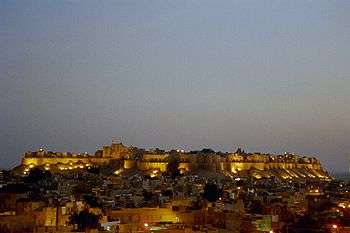
- Agra
- Ahmedabad
- Amravati
- Amritsar
- Datia
- Delhi
- Dholavira
- Hyderabad
- Jaipur
- Jaisalmer
- Jodhpur
- Lucknow
- Mumbai (old city of Bombay)
- Raigad
- Udaipur
- Warangal
- Chennai
- Mhow
Indonesia
An 18th century wall, made by Hamengkubuwono the 1st from Ngayogyakarta Hadiningrat Kingdom to protect the inner capital city from the Dutch and other enemy during the Mataram Kingdom Period. Today, the wall still exist almost 96% and being one of many landmark in the city.
On 17 February 1745, the Surakarta Kingdom moved to a new opened forest named Sala Village and build their Royal Residential Palace and urban area with a 15 kilometers long of "Beteng Kraton" or Palace wall around it. The wall was 90% exist.
- Surosowan
Well known as Banten Kingdom's capital. The wall was destroyed by the Dutch during its colonial period in the way to ended the Banten reign. The city wall that left is only about 10% from the real appearance.
Trowulan was the capital of the former Majapahit Empire. When its glory period, the capital being a first European systemized ancient city (with city canal system for transportation and also large aisle and road for major transportation)in Indonesia, because Trowulan was developed in Majapahit's glory period in 13th-15th century. The wall was protecting the inner "Kraton" or royal palace and some important places. Today the wall can't be seen as the original appearance.
Iran
Iraq
Israel
- Acre – 18th-century modern Ottoman fortification able to withstand cannon attack. The wall has been restored and now includes a rampart for tourists.
- Jaffa
- Jerusalem
- Safed
- Tiberias
Lebanon
- Baalbek: sections of the Arab fortifications (built with stones from Roman structures) can still be seen around the Acropolis and the old town
- Batroun: the town is known for its 225 m long Phoenician seawall. There was also a 9th-century BC citadel, parts of which are still visible
- Beirut: sections of the Phoenician and Roman fortifications and Ottoman citadel have been unearthed in the city's central district. The famous walls erected by Emir Fakhruddin II have yet to be recovered.
- Byblos: the old town is surrounded by medieval walls, with a castle standing at their Southern edge
- Sidon: little remains today of the city's medieval fortifications, except the Castle of St. Louis.
Malaysia
- Malacca - Built by the Portuguese after the city's occupation in 1511, it was torn down by the British in 1806. Known locally as the A Famosa.
Pakistan
Almost every old city in Pakistan had a defensive wall. Much of these walls were destroyed by the British in order to refortify the cites. Few cities which were fortified are:
Philippines
- Cebu (see Fort San Pedro)
- Manila (Intramuros) – partially preserved, partially restored after World War II. Original walls are still well preserved.
- Olongapo ("Spanish Gate")
- Ozamiz (Fuerte de la Concepción y del Triunfo)
- Zamboanga (see Fort Pilar)
South Korea
- Busan (See Dongnaeeupseong.)
- Seoul (See Fortress Wall of Seoul.)
- Suwon (See Hwaseong Fortress.)
- Gyeonggi-do Gwangju-si (See Namahansanseong.)
Sri Lanka
- Galle (See Galle Fort.)
- Matara (See Matara Fort.)
Syria
Thailand
| Wikimedia Commons has media related to City walls in Thailand. |
- Ayutthaya
- Bangkok
- Chiang Mai was surrounded by a moat and city walls when it was established by King Mangrai the Great in 1296. They were extensively rebuilt in the early 19th century. Large parts of the city walls and city gates of Chiang Mai survived till the present.
- Chiang Rai
- Chiang Saen
- Kamphaeng Phet
- Lampang
- Lamphun
- Lopburi
- Nakhon Ratchasima
- Nakhon Si Thammarat
- Nan, Thailand
- Phichai
- Phayao
- Phimai
- Phitsanulok
- Phrae
- Si Satchanalai
- Songkhla
- Sukhothai
- Suphanburi
- Thonburi
- Wiang Kum Kam
Uzbekistan
Vietnam
West Bank
Yemen
Europe
Albania
Austria
- Allentsteig
- Amstetten Not walled but ditched and banked with gate towers.
- Bleiburg
- Bludenz
- Braunau am Inn
- Bregenz
- Bruck an der Leitha – partially preserved
- Bruck an der Mur
- Donnerskirchen.
- Drosendorf
- Dürnstein
- Ebenfurth
- Eferding
- Eggenburg
- Eisenstadt
- Enns
- Fehring
- Feldkirch
- Friedberg
- Freistadt – almost completely preserved
- Friesach
- Fürstenfeld
- Gmünd
- Gmuend-in-Kaernten
- Gmunden
- Graz
- Gross-Enzersdorf
- Güssing
- Hainburg an der Donau – almost completely preserved (2.5 km, 3 gates, 15 towers)
- Hallein
- Hall in Tirol – partially preserved
- Hardegg
- Hartberg
- Haslach an der Muhl
- Heidenreichstein
- Herzogenburg
- Horn
- Judenburg
- Kitzbuhel
- Klagenfurt
- Klosterneuburg
- Knittelfeld
- Korneuburg
- Krems
- Kufstein
- Laa an der Thaya
- Leoben
- Leonfelden
- Leoben
- Lienz
- Linz
- Litschau
- Maissau
- Marchegg – some segments preserved
- Mautern - remains of the Roman fortress "Favianae" can be found at the western side of the old town.
- Melk
- Murau
- Mürzzuschlag
- Neumarkt am Wallersee
- Neumarkt
- Obdach
- Oberwölz
- Oggau am Neusiedler See
- Ottensheim
- Peuerbach
- Pöchlarn
- Purbach am Neusiedler See
- Raabs an der Thaya
- Radfeld
- Radkersburg
- Radstadt – almost completely preserved wall (13th- to 16th-century); 3 round towers (1530s); 1 gate
- Rattenberg
- Retz
- Ried im Innkreis
- Rottenmann
- Rust
- St Andrä
- Sankt Veit an der Glan
- St Pölten
- Salzburg
- Schärding
- Scheibbs
- Schladming
- Schrattenthal
- Schwanenstadt the settlement surrounded by a bank, surmounted by wooden palisade, with only a short length of wall adjacent to the ‘‘Stadtturm’’.
- Stadtschlaining
- Stainach
- Stein
- Straßburg
- Steyr
- Steyregg
- Traismauer
- Tulln an der Donau
- Vienna – destroyed and became the Ringstraße
- Villach
- Vils
- Vocklabruck
- Völkermarkt
- Voitsberg
- Waidhofen an der Thaya
- Waidhofen an der Ybbs
- Weitra
- Wels
- Wiener Neustadt
- Wilhelmsburg
- Wolfsberg
- Ybbs an der Donau
- Zeiselmauer. The Roman auxiliary fort was re-fortified by the Babenbergs in the 10th century, but never granted a market or charter.
- Zistersdorf
- Zwettl
Azerbaijan
- Baku, retains most of the city walls that separate the historic Inner City from the newer parts of the city developed after the 19th century. (According to the CIA, Azerbaijan is more accurately placed in Asia, not Europe.)
Belgium
| Place | Province | Accessible | Condition | Image | Notes |
|---|---|---|---|---|---|
| Aarschot | Flemish Brabant | Yes | One or more individual structures (Bastions, gates towers, etc.) remain. | The most significant remain of the medieval fortifications which surrounded the town of Aarschot is a tower located on top of a hill just south of the old town, named the Aurelianustoren or Orleanstoren. | |
| Ath | Hainaut | Yes | One or more individual structures (Bastions, gates, towers, etc.) remain. |  |
Ath was fortified several times during its history. Of the oldest fortifications, the old castle, including the Burbant Tower, still stands. The bendy course of some of the streets surrounding the old town are vestiges of the bastioned ramparts of the post-medieval era. Some remnants of these fortifications still remain to the north of the old town, near the Boulevard Alphonse Deneubourg. |
| Arlon | Luxembourg | Yes | One or more individual structures (Bastions, gates, towers, etc.) remain. |  |
A smallish citadel stands in the center of the old town, on the location of a destroyed Medieval castle. |
| Beaumont | Hainaut | Yes | One or more individual structures (Bastions, gates, towers, etc.) remain. | A sizable stretch of the old city wall remains to the east of the old town. The most notable part is the old Tour Salamandre, an old keep tower. | |
| Binche | Hainaut | Yes | Sizable parts of the fortifications remain intact. |  |
The city of Binche sports the most intact set of city walls of Belgium. Built in 1230 AD, they are 2.1 kilometers long and sport about 30 towers. There were six gates, but these have been demolished in the 19th century. |
| Bouillon | Luxembourg | Yes | One or more individual structures (Bastions, gates, towers, etc.) remain. | Apart from the impressive medieval castle, three small, tower-like bastions, as well as several small stretches of curtain wall, remain of the wall built around the town by the French military engineer Vauban in the 17th century. | |
| Bruges | Western Flanders | Yes | One or more individual structures (Bastions, gates, towers, etc.) remain. |  |
Out of the nine gates in the 14th-century walls, four survive today. Several stretches of the earth fortification wall surrounding the city are still in place. Apart from a single tower, no trace remains of the stone wall that topped some parts of the earth ramparts. A single tower of the first city wall can be seen across the canal at the Pottenmakersstraat. |
| Brussels | Brussels-Capital Region | One or more individual structures (Bastions, gates, towers, etc.) remain. |  |
Of the first city wall, built in the 13th century, a small stretch of curtain wall and several isolated towers still remain. Of the second wall, only the Halle gate remains. The inner ring road of Brussels now occupies the location of this second wall. | |
| Chièvres | Hainaut | Yes | One or more individual structures (Bastions, gates, towers, etc.) remain. | A large stretch of the medieval town walls still remains behind the church of Our Lady (Notre Dame) and the houses alongside the Rue Hoche. A wall tower, the Tour de Gavre, also remains next to the church. | |
| Chimay | Western Flanders | One or more individual structures (Bastions, gates, towers, etc.) remain. | An isolated tower still remains at the Rue de Noailles | ||
| Damme | West Flanders | Yes | One or more individual structures (Bastions, gates, towers, etc.) remain. |  |
The location of the 16th-century, seven-sided ring of fortifications can still be seen as low hills in the fields and gardens surrounding the old town. A small portion of the inner and outer wall was reconstructed in 2001. |
| Dendermonde | East Flanders | Yes | One or more individual structures (Bastions, gates, towers, etc.) remain. |  |
Dendermonde received a new set of city walls in the 19th century, being an important part of the Wellington Barrier. Currently, various structures, including the arsenal, barracks, two gates, and several parts of the walls (transformed into a park) remain. |
| Diest | Flemish Brabant | Yes | Sizable parts of the fortifications remain intact. |  |
To the north of the city centre, one can still find two polygonous fronts featuring a land gate; a water gate and a ravelin. An outer wall in front of this wall fragment sports two dilapidated casemated caponieres. To the east, the shape of several bastions have remained intact. An outer work, to the east of the fortifications, is incorporated in a swimming pool complex. The Citadel remains mostly intact, although the side facing the city was demolished to make room for barracks. There is a small fortress to the north of the city center. |
| Herentals | Antwerpen | One or more individual structures (Bastions, gates, towers, etc.) remain. |  |
Two, much altered, gates of the Medieval fortifications of the town of Herentals can still be found at either end of the town center. | |
| Huy | Liège | Sizable parts of the fortifications remain intact. | Sizable portions of the medieval city wall can be found to the south and east of the old town. During the early 19th century, a large fortress was built by the Dutch on the location where a castle had stood several centuries before. | ||
| Kortrijk | Western Flanders | One or more individual structures (Bastions, gates, towers, etc.) remain. |  |
The extensive fortifications of Courtrai have been demolished during the mid-18th century. The only remains are the Medieval Broel towers, standing on either side of the river Lys. A foundation of a defensive wall and a multi angular artillery tower, both situated adjacent to the church of Our Lady, form the last remnants of the first castle of Courtrai. | |
| Leuven | Flemish Brabant | One or more individual structures (Bastions, gates, towers, etc.) remain. |  |
Several dilapidated towers and fragments of the Romanesque 12th-century first wall of Leuven can be found throughout the city centre, although a sizeable portion collapsed due to negligence in February, 2011. Of the second wall, only the ground floor of a watchtower and the base of a watergate over the Dijle river still stand. The second wall was changed into a park in the 19th century, this park was largely destroyed and replaced by a ring road in the 20th century. | |
| Liège | Liège | One or more individual structures (Bastions, gates, towers, etc.) remain. | 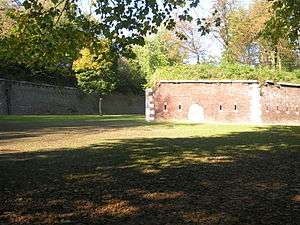 |
Several towers and fragments of the medieval city wall remain on the slopes to the north of the old town. The south side of the citadel, featuring three bastions and two ravelins, remains intact. The rest of the citadel was demolished and now the site houses a large hospital. A ring of detached fortresses still encloses the city. In the 19th century, the Dutch constructed large fortress the Chartreuse heights to the east of the city. Although the eastern bastions have been demolished, most of this fortress still stands, be it in a ruinous state after having been neglected since the 1980s | |
| Limbourg | Liège | Sizable parts of the fortifications remain intact. |  |
Although partially demolished, sizable remnants of the city wall can still be seen, surrounding the upper town of Limbourg. The best preserved stretches are located on the eastern side of the old town. | |
| Lo-Reninge | West Flanders | One or more individual structures (Bastions, gates, towers, etc.) remain. | 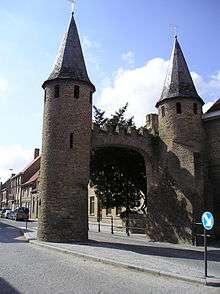 |
Only the Westpoort, built around 1250 CE, and consisting of two small towers connected by an arch, remains. | |
| Middelburg | West Flanders | Vestiges of the fortifications are visible in the landscape. | Nothing remains above ground of the earth bastions that surrounded this tiny village (which should not be confused with its nearby, much larger Dutch namesake), but the location and course of the defences can still be recognized from air. | ||
| Mechelen | Antwerpen | One or more individual structures (Bastions, gates, towers, etc.) remain. |  |
Only the Brusselsepoort (Brussels Gate) remains of the old fortifications of Mechelen. | |
| Menen | West Flanders | Yes | One or more individual structures (Bastions, gates, towers, etc.) remain. |  |
Several fragments of the bastioned trace, first built by the French in the 17th century, but extensively rebuilt by the Dutch, remain. Two bastions are still remaining near the Sluizenkaai and Zwemkomstraat, though heavily built by houses. The casemates of one of the bastions remain intact and can be visited. |
| Mons | Hainaut | One or more individual structures (Bastions, gates, towers, etc.) remain. | Several fragments of the first city wall of mons have been preserved. Of the later defences, only two bastion-like structures remain to the south of the city centre, but the location of the fortifications can still be seen in the zig-zagging street pattern on the east side of the city. | ||
| Namur | Namur | Yes | One or more individual structures (Bastions, gates, towers, etc.) remain. |  |
Of the defences of the city itself, the enormous arsenal building is the most notable remnant. Some remnants of the bastioned defences may be found in the Parc Louise Marie, as well as at the foot of the citadel. Only small fragments remain of the medieval city wall, most notably a strong round tower, now incorporated into the town hall as the city's belfry. The mighty citadel that grew out of the medieval count's castle, remains mostly intact and can be visited. |
| Ninove | East Flanders | One or more individual structures (Bastions, gates, towers, etc.) remain. |  |
Only the Koepoort (Cow Gate) remains of the old walls of the town of Ninove. | |
| Oostende | West Flanders | One or more individual structures (Bastions, gates, towers, etc.) remain. |  |
A portion of the bastioned city wall remains to the south of the town center, transformed into a park. East of the harbor stands an old advanced fortification, known as the Halve Maan (Crescent Moon). A short distance further to the east stands the 19th-century Fort Napoleon, now a museum. | |
| Philippeville | Namur | Yes | Vestiges of the fortifications are visible in the landscape. | Although the walls themselves were demolished in 1860, an extensive system of 17th-century underground passages remain. A portion of these fortifications is open to the public. | |
| Thuin | Hainaut | One or more individual structures (Bastions, gates, towers, etc.) remain. | Several towers and fragments of wall remain around the old fortress town of Thuin, most notably to the south of the old town, above the Hanging Gardens. | ||
| Tongeren | Limburg | Yes | One or more individual structures (Bastions, gates, towers, etc.) remain. |  |
Important parts of the 13th-century wall, including several towers and a gate, remain. Outside the medieval town, one can still find remnants of the first Roman wall, which enclosed a much larger area than the medieval wall. Of the much smaller second Roman wall, no above-ground remnants remain. |
| Tournai | Hainaut | One or more individual structures (Bastions, gates, towers, etc.) remain. |  |
Remnants of fortifications can be found scattered throughout the old town. Of the first fortifications, several towers and a gate remain. Of the second medieval wall, a sizable portion remains to the south-east of the old city, while the Pont des Trous, although severely altered, remains an impressive example of a medieval water gate. A large round tower is all that remains from the fortress built by English king Henry VIII. Of the citadel, only the interior buildings remain, as well as several underground passages which ran underneath the bastions of the fortress. | |
| Veurne | West Flanders | Vestiges of the fortifications are visible in the landscape. |  |
The bendy route of the canal as well as the street plan around the city centre clearly indicate the location of the earthen bastions that used to surround the city. | |
| Ypres | West Flanders | Yes | Sizable parts of the fortifications remain intact. | A wall with 3 unusually flat bastions defends the east side of the city. To the south a medieval gate and the lower portions of two medieval towers can be found. Both towers are defended by a ravelin. A park to the east of the city houses a number of underground passages belonging to outworks built by the Dutch. | |
| Zandvliet | Antwerp | Vestiges of the fortifications are visible in the landscape. | The "Conterscherp" road follows the route of the former 17th-century defences around the city, giving the town centre a star shaped appearance from the air. | ||
| Zichem | Flemish Brabant | One or more individual structures (Bastions, gates, towers, etc.) remain. | The Maagdentoren (Maiden Tower) is what remains of the medieval town walls. A ring road indicates the trace of the now demolished fortifications. | ||
| Zoutleeuw | Flemish Brabant | One or more individual structures (Bastions, gates, towers, etc.) remain. | Remnants of the first 12th-century city wall and a gate can be found incorporated in the old city hall and the adjacent house. Outside the city, a bridge over the river Gete incorporates a partial reconstruction of a 14th-century watergate belonging to the second wall. To the south of the city, several low hills in the landscape indicate the position of a Spanish-built citadel. To the east of the old town stands the “Heksenkot”, a tower of the old city wall. |
Bulgaria
- Hisarya - the old Roman town is still surrounded by the ruins of its defensive walls.
- Nessebar – small fortified island city
- Sozopol
- Sofia - established as walled city Ulpia Serdica by Trajan
- Veliko Turnovo – three fortified hills make one city
- Vidin
Croatia

- Buje
- Dubrovnik has well-preserved city fortifications including towers, gate, rampart walk and two citadels guarding the docks. Walls of Dubrovnik are among the finest and most complete in Europe.
- Hvar
- Korčula
- Krk city walls which obtained their current appearance between the 12th and the 15th centuries but the town itself was fortified since Roman period.
- Karlovac city walls, built in 1579 as a six-point star with bastions.
- Motovun
- Nin, Croatia
- Novigrad
- Grožnjan
- Omišalj
- Oprtalj
- Pag
- Poreč
- Roč
- Rovinj
- Senj
- Sibenik
- Split – several remains of the defensive walls of Diocletian's Palace still survive to this day, including 3 gates and long stretches of the fortified Roman walls. Most of the towers are now demolished, apart from 3 square towers, each of them located at a corner of the palace. North of the town centre are the remains of a bastionned trace, which includes portions of the walls and a bastion located in a park.
- Ston: Walls of Ston were built in 14th and 15th centuries, at the isthmus of the Pelješac peninsula, to the north of Dubrovnik; 890 meters long town wall and 5 km Great Wall outside the town Ston.
- Trogir
- Zadar retains about half of its wall
Cyprus
| Place | Condition | Image | Notes |
|---|---|---|---|
| Famagusta | Intact | 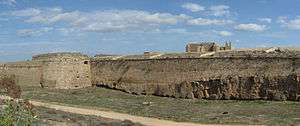 |
Main article: Fortifications of Famagusta The first major fortification in Famagusta was the Othello Tower, which was built by the Lusignans in the 14th century and was later modified by the Venetians. The latter also built city walls in the 15th and 16th centuries, and they remain intact today. |
| Nicosia | Mostly intact | 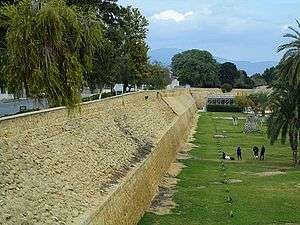 |
Main article: Walls of Nicosia The first fortifications in Nicosia were built in the 13th and 14th century. The Venetians demolished the medieval fortifications and replaced them with a circular bastioned enceinte in the late 1560s. The walls remain largely intact except for some breaches. |
Czech Republic
_(7).jpg)
- Bechyně
- Bělá pod Bezdězem
- Benátky nad Jizerou
- Beroun
- Bochov
- Bor u Tachova
- Brno
- Broumov
- Bruntál
- Čáslav
 Čáslav, wall and tower
Čáslav, wall and tower - Česká Lípa
- České Budějovice
- Český Brod
- Český Dub
- Český Krumlov
- Cheb
- Chrudim
- Chyše
- Dačice
- Domažlice
- Dvůr Králové nad Labem
- Frýdlant
- Fulnek
- Havlíčkův Brod
- Hlučín
- Horažďovice
- Horšovský Týn
- Hostinné
- Hradec Králové
- Hranice
- Jablonné v Podještědí
- Jaroměř
- Jindrichuv Hradec
- Jevíčko
- Jičín
- Jindřichův Hradec
- Josefov- originally known as Ples
- Kadaň
- Klatovy
- Kolín
- Kostelec nad Labem
- Kouřim
- Krnov
- Kutná Hora
- Kromeriz
- Lanškroun
- Lipník nad Bečvou
- Litomyšl
- Litovel
- Loket (Sokolov District)
- Louny
- Mělník
- Mladá Boleslav
- Náchod
- Nové Město nad Metují
- Nový Bydžov
- Nový Jičín
- NymburkNymburk walls
- Odry
- Olomouc
- Opočno
- Opava
- Osoblaha
- Ostrava
- Ostrov
- Pardubice
- Písek
- Planá u Mariánských Lázní
- Plzeň
- Plumlov
- PoličkaPolicka Wall and Bastion
- Prachatice
- Prague Hradčany
- Prague Malá Strana
- Prague Staré Město
 Prague Pulverturm, Gate to the Staré Město
Prague Pulverturm, Gate to the Staré Město - Prague Nové Město
- Prague Vyšehrad
- Přelouč
- Prostějov
- Přerov
- Rabštejn nad Střelou
- Rakovnik
- Rataje nad Sázavou
- Rokycany
- Rožmitál pod Třemšínem
- Slaný
- Soběslav
- Sobotka
- Stará BoleslavCity gate, Stara Boleslav
- Šternberk
- Štramberk
- Strážnice
- Stříbro
- Svitavy
- Šumperk
- Sušice
- Tábor
- Tachov
- Teplá
- Tovačov
- Třeboň
 Třeboň Town wall and defensive bastions
Třeboň Town wall and defensive bastions - Trutnov
- Toužim
- Uničov
- Ústí nad Orlicí
- Velvary
- Vidnava
- Vraný
- Vysoké Mýto
- Zábřeh
- Zákupy
- Žatec
- Žlutice
- Znojmo
 Znojmo. Town wall and Rotunda
Znojmo. Town wall and Rotunda
Denmark
- Fredericia, extensive renaissance ramparts to the north and west of the city and sea facing ramparts.
- Copenhagen, extensive renaissance ramparts to the south and east, trace remains to the north and west, nice fort at the harbor mouth, three small island fortlets outside the harbor entrance.
- Nyborg – the remains include three preserved bastions, a town gate and the old town is still mostly surrounded by a moat indicating the locations of the other (now demolished) bastions.
Estonia

- Haapsalu
- Narva
- Paide
- Pärnu, a rampart with two bastions, a moat and a town gate remain to the west of the old town. It is now transformed into a park, the Valli Park.
- Tallinn, see Tallinn City Walls, most of the wall and towers remains
- Tartu, very few sections remained
- Viljandi
- Rakvere
Finland

- Hamina Surrounded by about 4–5 km long star-shaped walled fortification
- Suomenlinna An inhabited sea fortress off the coast of Helsinki
France
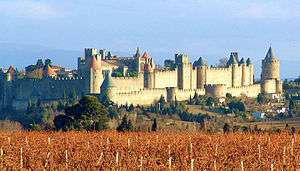
- Aigues-Mortes
- Angers – Roman wall partially extant
- Angoulême
- Annecy
- Antibes
- Arles (partial remains)
- Arnay-le-Duc
- Arques-la-Bataille - fragmentary remains.
- Autun has many sizable parts of the town walls, alongside the Boulevard des Résistants Fusillés, Boulevard Mac Mahon, Rue du Vieux Colombier, Rue Gaston Joliet, Boulevard Laureau, Rue des Cités, and alongside the river L'Arroux. Two Roman town gates remain, the ruined Porta Senonica and the well-preserved Porte Saint-André.
- Auxonne
- Avallon
- Avesnes-sur-Helpe
- Avignon
- Avranches
- Bastia
- Bavay - some sections of the walls still remain, dating back to Roman times. Ruins of the Roman Forum can be found at the Western part of the old town.
- Bayeux - fragmentary remains. A tower and some stretches of walls remain alongside a car parking area behind the Rue Saint-Malo. Stretches of walls also still remain alongside the Rue Tardif, and are now used as garden walls. A section of the foundations of the walls still remains directly behind the Bayeux Cathedral. The walls date back to the Roman era.
- Bayonne
- Beaune
- Belfort
- Bergheim, Haut-Rhin
- Bergues
- Blaye
- Bœrsch
- Boulogne-sur-Mer (complete enclosure of old town)
- Bourges
- Boussac
- Bonifacio
- Brest
- Briançon - The walled town of Briançon is one of the most heavily fortified towns in France. The walls remain fully intact.
- Bruch, Lot-et-Garonne - parts of the medieval town walls still remain. Including a town gate which also serves as the town's belfry tower, and a tower named Tour Nord.
- Caen
- Carcassonne (restored (massively) by Viollet-le-Duc)
- Carignan
- Charleville-Mézières the town is a merge of two towns, Charleville and Mézières were both fortified. The only remnant of the walls of Charleville is the fortified tidal mill, which now houses the Rimbaud museum. Mézières, the oldest town of the two, lies just south of Charleville. The old town of Mézières is still mostly enclosed by a moat. Sizable parts of the walls still remain at the north, west and south side of the old town including a tower and two round bastions. The only remaining town gate, the Porte Neuve with an adjacent round bastion, now houses the library.
- Chateau-Landon
- Châteauponsac - some small parts of the walls can still be found around the town.
- Châteauvillain
- Châtillon-Coligny – some parts still remain. One of the wall towers is converted into a clock tower.
- Chaumont-sur-Loire
- Clermont-L'Herault
- Collioure
- Colmars-les-Alpes
- Compiègne
- Concarneau's old town (ville close)
- Dambach-la-Ville
- Decize
- Die -
- Dinan (nearly complete ramparts with a large 14th-century keep known as the Donjon de la duchesse Anne )
- Dieppe there are two remainders of the town walls. The well-preserved Porte des Tourelles is the only remaining town gate. There is a remaining stretch of wall at the Quai Henry IV, once adjacent to the now demolished Tour des Anglais.
- Dol-de-Bretagne
- Domfront
- Donzenac - fragmentary remains, including a town gate.
- Dun-sur-Meuse ruins of the town walls still enclose the medieval part of the town called Dun Haute, the area around the church of Our Lady. One of the two town gates still survives, the Porte aux Chevaux.
- Entrevaux – the medieval town is still enclosed by impressive fortified walls. The citadel is situated on the top of a rock, overlooking the medieval town.
- Falaise there are fragmentary remains of the land side walls, alongside the Boulevard de la Liberacion. The walls at the river side, alongside the river L'Ante, are largely preserved and stretch from the castle to the ruins of the Porte Saint-Laurant. The Porte des Cordeliers is a well-preserved medieval town gate.
- Gondreville, Meurthe-et-Moselle
- Guérande (nearly complete ramparts with four fortified gates)
- Granville
- Gravelines
- Hennebont's old town: (partial remains of ramparts and large fortified châtelet)
- Honfleur the only remaining part of the town walls is the Porte de Caen, now a part of the Lieutenance building. The other gate was the Porte de Rouen.
- Joigny
- Kientzheim
- La Couvertoirade
- La Rochelle
- Lagny-sur-Marne
- Langres
- Laon
- Larressingle
- Laval
- Le Château-d'Oléron, renaissance city walls and nice-sized fortress
- Le Mans
- Le Quesnoy
- Lille
- Longwy
- Lusignan
- Marle
- Marsal, Moselle
- Marville
- Maubeuge
- Meaux
- Mehun-sur-Yèvre
- Montreuil, Pas-de-Calais
- Mont-Dauphin
- Mont-Louis
- Metz, defensive walls extending from 2nd BC until 20th AC, including partial remains of ancient Celtic and Gallo-Roman ramparts, High and Late Medieval fortifications, Vauban and Cormontaigne citadel, Séré de Rivières system, and Maginot line.
- Nantes – partial remains of medieval wall
- Neuf-Brisach
- Nevers has some remains of the medieval town walls. Most notably are a double town gate, the Porte du Croux, and some portions of wall and towers to the riverside of the town.
- Niedernai
- Obernai, some sections of ramparts remain.
- Parthenay
- Paris
- Penne-d'Agenais
- Péronne, Somme
- Pérouges
- Ploërmel
- Poitiers
- Port-Louis, Morbihan
- Porto-Vecchio
- Provins
- Quimper some parts of the walls remain around the old town. There is a stretch of a wall south of the cathedral alongside the river L'Odet. To the west of the town there is a large stretch of wall including a tower, and to the north of the town there is a stretch alongside the Place de la Tourbie. To the east there are som fragmentary remains, including a square shaped tower.
- Richelieu, Indre-et-Loire - large parts of the defensive walls surrounding the rectangular town centre still remain, including the two original town gates.
- Rocamadour
- Rocroi
- Rodez
- Rennes
- Sablet
- Saint-Hippolyte, Haut-Rhin
- Saint-Lô
- Saint-Malo
- Saissac
- Sant Vincent de Barrès
- Sarlat-la-Canéda
- Sarrebourg
- Saint-Malo, the city, including the whole wall, was rebuilt after bombing in WWII.
- Saint-Jean-Pied-de-Port
- Saint-Valery-sur-Somme
- Semur-en-Auxois
- Sisteron
- Thouars
- Toul
- Toulon
- Tours
- Trets
- Vannes
- Verdun substantial remains of the fortifications still remain along the Rue du Moulin la Ville, Rue du Grand Rempart and Rue de la Californie. The Canal Saint-Airy is part of the original moat. There are two bastions to the south east of the old town. To the north of the old town the bastion Saint-Paul still remains at the Rue du Bastion Saint-Paul. Two town gates remain, the Porte Porte Châtel and Porte Chaussée. On the opposite site of the Porte Chaussée, on the right bank of the Canal de l' Est in the Parc Japiot, are the remains of a bastion. The Citadel of Verdun, to the west of the old town, is one of the best preserved citadels in France. Inside the citadel are the ruins of St. Vannes abbey.
- Vernon some sizable stretches of the town walls still remain. One tower, the Tour des Archives, still remains.
- Vermand - the town is surrounded by the remains of earthwork ramparts, once belonging to the capital stronghold of the Viromandui tribe
- Vervins
- Vianne - most of the walls surrounding the medieval town are preserved. Including 4 town gates.
- Vieille-Brioude
- Villeneuve-sur-Yonne
- Vire of the medieval town walls 3 towers still remain. One town gate remains, the Porte Horloge.
- Viviers, Ardèche
- Wissembourg
Georgia
- Mestia (The "Svan towers".)
- Omalo
- Gori
- Kaspi
- Akhaltsikhe
- Telavi
- Mtskheta
- Signagi
- Rustavi
- Surami
- Kutaisi
Germany

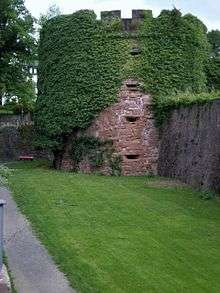




- Aachen, some parts of the inner walls still remain alongside Tempelgraben (at the corner with the Eilfschornsteinstraße and the corner with the Pontstraße), and at the back of the houses alongside Seilgraben. Of the outer walls three towers, the Langer Turm, Pfaffenturm and the Marienturm, still stand today. The two remaining city gates, Ponttor and Marschiertor, are among the best preserved gates in Germany.
- Aach
- Abensberg
- Ahrweiler
- Aichach
- Altentreptow – the remains include some stretches of wall, a tower and two town gates, the Brandenburger Tor and the Demminer Tor.
- Annaberg-Buchholz
- Amberg
- Amöneburg
- Andernach
- Arberg - only one town gate remains.
- Arnstadt
- Aschaffenburg
- Aub – large sections of the walls remain, including some towers. One town gate remains, the Zentturm.
- Babenhausen
- Bad Colberg-Heldburg
- Bad Frankenhausen
- Bad Hersfeld
- Bad Langensalza – large parts of the walls still remain today, including 12 wall towers and one city gate, the Klagetor.
- Bad Münstereifel
- Bad Neustadt an der Saale
- Bad Orb
- Bad Rodach
- Bad Sooden-Allendorf
- Bad Waldsee
- Bad Wimpfen
- Bacharach
- Ballenstedt
- Barby
- Bautzen
- Beilngries
- Berching
- Berlin had a defensive wall around the city from about 1250 until the mid-17th century, and a Customs Wall from the mid-18th to the mid-19th centuries. The Berlin Wall that existed from 1961 to 1989 was claimed by the authorities of East Germany to be defensive, but in fact it was rather intended to prevent unauthorized emigration. Parts of Berlin's medieval wall still remain alongside the Littenstraße.
- Bernau bei Berlin
- Bernkastel - a stretch of wall remains to the south of the town.
- Besigheim
- Blankenburg (Harz)
- Bodenwerder
- Boizenburg
- Boppard
- Bönnigheim – some parts of the walls and a town gate remain.
- Brandenburg
- Buchen
- Burgau
- Burg bei Magdeburg
- Burghausen
- Butzbach
- Büdingen
- Calbe
- Chemnitz - only one tower remains, the Roter Turm (Red Tower).
- Coburg
- Crailsheim – some remains are located north of the Ringgasse, including a wall tower. Another tower remains alongside the Grabenstraße.
- Darmstadt
- Dausenau – the walls remain almost intact. One town gate still remains, the Torturm.
- Delitzsch
- Demmin large parts of the city walls still remain alongside Nordmauer, Bauhofstraße and Südmauer. One town gate still remains, the Luisentor.
- Dettelbach
- Dillingen
- Dilsberg
- Dinkelsbühl – the medieval town walls remain fully intact, including 4 gates and 19 towers.
- Dollnstein
- Dömitz
- Donauwörth
- Dresden - Dresden’s Defensive walls were some of the first in Germany, inspired by the earlier Italian model. The walls surrounded both the ‘Old City’ south of the Elbe, and the ‘New City’ to the north. The walls, gates and moats were largely removed c.1815, following the Napoleonic Wars, being deemed outmoded for modern warfare. Some small sections have been rediscovered and established as the Museum Festung Dresden http://www.festung-dresden.de/de/festung_dresden/museum/ below the more famous Brühl Terrace.
- Duderstadt
- Duisburg
- Ebern
- Eberbach (Baden)
- Eibelstadt
- Eichstätt
- Einbeck
- Eisenheim
- Ellwangen
- Eltville am Rhein
- Emden
- Engen
- Erding
- Erlangen – some stretches of wall still remain alongside Nördliche Stadtmauerstraße, Wöhrstraße and Schulstraße.
- Feuchtwangen
- Fladungen
- Forchheim
- Freiberg
- Freyburg, Germany
- Freystadt
- Friedberg, Bavaria
- Freinsheim
- Frickenhausen am Main
- Fritzlar
- Gangelt
- Gardelegen – there are several remains of the old town wall, including the impressive Salzwedeler Tor, the remains of the Stendaler Tor, and some stretches of wall.
- Gartz (Oder) - The remains of the walls around the medieval town include some sizable stretches of walls, towers and one town gate, the Stettiner Tor.
- Geisa
- Gelnhausen
- Germersheim
- Gerolzhofen
- Göllheim – two town gates are preserved, the Kerzenheimer Tor and the Dreisener Tor. One tower remains, the Ulrichsturm.
- Gräfenberg – the remains include three well-preserved town gates, the Egloffsteiner Tor, the Hiltpoltsteiner Tor and the Gesteiger Tor. Some parts of the walls still remain adjacent to the Gesteiger Tor and at the back of the houses alongside Am Gesteiger and Schulgasse.
- Grebenstein - most of the medieval walls are still surrounding the old town. One town gate remains, the Burgtor.
- Greding
- Grimma
- Grimmen one tower still remains, the Wasserturm. All three of the original town gates also remain, the Stralsunder Tor, Greifswalder Tor and the Mühlentor.
- Großostheim
- Gundelfingen an der Donau
- Gundelsheim
- Gunzenhausen
- Güstrow - remains of the walls remain south of the cathedral and alongside the Gelviner Mauer. The town
- Haldensleben
- Hannoversch Münden
- Hattingen
- Heidelsheim – one town gate and a wall tower still remain today.
- Heidingsfeld, today part of Würzburg
- Heilbad Heiligenstadt
- Herborn
- Herrieden
- Hildburghausen
- Hirschhorn
- Haldensleben
- Hammelburg
- Hardgesen
- Hollfeld – the remains include one town gate, the Obere Tor, and some parts of the walls to the south of the old town.
- Homberg, Efze
- Horn
- Höchstadt an der Aisch
- Höchstädt an der Donau
- Horb am Neckar – large sections of the walls still remain. One town gate, the Ihlinger Tor, still remains, and some towers still remain, most notably the Schurkenturm and the Schütteturm.
- Höxter
- Hünfeld
- Ingelheim am Rhein - sizable remains, including stretches of wall, the Malakoffturm, the Bismarckturm, Ohrenbrückertor, Uffhubtor and the ruined Heidesheimer Tor. The medieval town centre also houses the ruins of the Ingelheimer Kaiserpfalz.
- Ingolstadt
- Iphofen
- Jena
- Karlstadt am Main
- Kaub
- Kaufbeuren
- Kemnath - several sections and towers of the walls remain around the medieval town. The eastern town gate was later converted into a church tower.
- Kempen - some parts of the walls still remain. They include the Kuhtor, a well-preserved town gate, the Mühlenturm and the remains of another town gate, the Peterstor.
- Kindelbrück
- Kirchberg an der Jagst
- Kirchhain
- Kitzingen
- Kroppenstedt
- Korbach
- Kranenburg
- Kronach
- Kulmbach
- Kuppenheim
- Kyritz
- Ladenburg
- Landsberg am Lech
- Landshut
- Langenzenn
- Laucha an der Unstrut
- Lauchheim
- Lauingen
- Lauf an der Pegnitz
- Laufen
- Lauffen am Neckar - the old town consists of three parts. While the town is divided by the river Neckar, the castle stands on a small island circled by the river. On the left bank there is a sizable stretch of wall is located next to the church. On the right bank, some towers, stretches of wall and the Neues Heilbronner Tor still remain.
- Leonberg
- Leutershausen
- Löbejün
- Lohr am Main
- Lübben
- Luckau
- Magdeburg
- Mainbernheim
- Maintal – large sections of the walls still remain, notably to the north of the medieval town.
- Mainz – the remains include the well-preserved square-shaped citadel, the medieval Alexanderturm, and the remains of a bastion alongside the Augustusstraße.
- Malchin two town gates still remain, the Kalensches Tor and the Steintor. Some parts of the walls to the south and east of the town still remain.
- Marbach am Neckar
- Markt Einersheim – two town gates still remain.
- Marktbreit
- Mayen
- Meisenheim
- Mellrichstadt
- Memmingen
- Meppen – the remains include a star shaped moat around the medieval town.
- Merkendorf
- Meyenburg
- Miltenberg
- Mindelheim
- Möckmühl
- Monheim – two town gates remain, the Oberes Tor and the Unteres Tor.
- Mühlhausen
- Müncheberg
- Munich has some of its former city gates still standing, and a section of its late 13th-century defensive wall.
- Münnerstadt
- Münzenberg – fragments of the walls remain, including two towers.
- Monheim – some stretches of wall still remain and both town gates, the Oberes Tor and the Unteres Tor, are preserved.
- Nabburg
- Naumburg
- Neckarsulm
- Neubrandenburg
- Neubrunn
- Neuburg an der Donau – some parts of the medieval walls still remain, including the Unteres Tor. The trace of the later bastionned earthworks, the so-called Untere Schanze, Elias Holl Schanze and Oberer Schanze, is still recognizable in the fields and from the air.
- Neudenau
- Neuenstadt am Kocher
- Neuenstein
- Neuleiningen
- Neumarkt in der Oberpfalz
- Neunkirchen am Brand – three town gates still remain, the Forcheimer Tor, the Erleinhofer Tor and the Erlanger Tor.
- Neuss
- Neustadt (Hessen)
- Neustadt an der Aisch – substantial parts of the walls still remain, including some towers and a well-preserved town gate, te Nürnberger Tor.
- Neustadt in Holstein - one town gate remains, the Kremper Tor.
- Niedernberg - several stretches of the walls wall remain. One wall tower remains at the riverside end of the Turmgasse
- Niedernhall – most of the town walls remain intact.
- Nordhausen
- Nördlingen
- Nürnberg
- Obernburg am Main
- Oberwesel
- Ochsenfurt
- Oebisfelde
- Oettingen
- Öhringen
- Oldenburg
- Oppenheim – some stretches of the town walls remain near the ruins of Landskron castle. One town gate and two towers remain, the Gautor, the Ruprechtsturm and the Uhrturm.
- Ornbau
- Orsoy
- Ortenberg
- Oschatz
- Ostheim
- Paderborn
- Pappenheim
- Pasewalk
- Tribsees – two town gates remain, the Steintor and the Mühlentor
- Trier-Pfalzel
- Pfullendorf
- Pößneck
- Potsdam
- Prenzlau there are some good remains of the walls, especially North, East and South of the town. 4 gates still remain, the Steintor, Wasserpforte, Mitteltor and the Blindower Tor. The walls also include 25 towers.
- Prenzlin
- Prichsenstadt
- Querfurt
- Radolfzell am Bodensee
- Ratingen
- Ravensburg – three town gates still remain, the Frauentor, Obertor and the Untertor. Nine of the original ten wall towers still remain, most notably a tower named Mehlsack.
- Recklinghausen two defensive towers and some portions of wall still remain today, north west of the old city.
- Reichelsheim – three towers remain.
- Rodach
- Rees - large parts of the town walls still remain intact, mainly located at the riveerside of the town and in the parks at the north-east and west side of the medieval town.
- Rheinbach
- Rheinberg
- Rhens – the town walls remain largely intact. Three town gates still remain, the Rheintor, the Josephstor and the ruins of the Viehtor.
- Rostock
- Röttingen
- Roth
- Rothenburg ob der Tauber
- Rottweil
- Rüthen
- Salzkotten
- Salzwedel
- Schleusingen
- Schlüsselfeld
- Schongau, Bavaria
- Schrobenhausen
- Schwaigern
- Schwalmstadt – the remains of a town gate still survive, the medieval Lüdertor. The earthworks are mostly demolished, leaving a moat of which the course indicates the location of four round bastions.
- Schweinfurt
- Seehausen - the moat still surrounds most of the medieval town. Fragments of the walls are to be found at the southern side of the old town. One town gate still remains, the Beustertor.
- Seßlach
- Seligenstadt – the remains include the Steinheimer Torturm, the Pulverturm and a tower at the Friedhofsmauer.
- Segnitz
- Soest
- Sommerach
- Sömmerda
- Sommerhausen
- Spalt
- Spangenberg
- Stade
- Staßfurt
- Stadt Blankenberg
- Steinheim
- Steinau an der Straße
- Stendal – two town gates still remain.
- Sternberg
- Stadtsteinach
- Stralsund
- Sulzbach – sizable parts of the walls and towers still remain. One town gate is preserved, the Rosenberger Tor.
- Sulzfeld am Main
- Tangermünde – most of the town walls still remain, including some towers.
- Templin
- Themar
- Treysa – the remains are located mainly South, East and North of the old town.
- Trier, portions of the city walls still exist, but the size of the Roman gate, the "Porta Nigra", gives evidence of the importance of the city. Other Roman remains include the baths, the Constantine Basilica, an amphitheater, and a 2nd-century AD Roman bridge.
- Torgau
- Überlingen
- Uffenheim
- Ulm an der Donau
- Villach
- Villingen
- Vilseck
- Vilshofen an der Donau
- Vellberg
- Volkach
- Waiblingen
- Waldenburg
- Waldfeucht
- Wangen im Allgäu
- Warburg (Westfalia)
- Wassertrüdingen
- Wemding
- Weikersheim
- Weil der Stadt
- Weilrod – the only town gate still remains.
- Weißenburg (Bavaria)
- Werben – one town gate still remains to the north east of the medieval town, the Elbtor. A tower with adjacent portion of the town wall remains to the west of the medieval town.
- Wertheim
- Wettenberg
- Windsbach
- Winterhausen
- Wittstock
- Woldegk
- Wolframs-Eschenbach
- Worms, Germany
- Wörth am Main
- Wunsiedel 3 towers, small portions of the walls and a town gate (Koppetentor) still remain.
- Würzburg
- Xanten
- Zeil am Main
- Zerbst
- Zons
- Zülpich
- Zwickau
Gibraltar
Greece

Many towns and cities still retain at least parts of their defensive walls, including:
- Arta
- Chania - see Fortifications of Chania
- Chios
- Corfu (city)
- Drama, Greece - sizable parts of the town walls remain to the north and east side of the old town. Including 2 towers and stretches of wall.
- Heraklion - see Fortifications of Heraklion
- Ioannina - see Ioannina Castle
- Kastoria - fragmentary remains.
- Kavala (a significant part of the seaside walls survive)
- Kissamos
- Komotini
- Koroni - preserved fortifications of the castle and upper town.
- Missolonghi
- Monemvassia
- Mystras
- Nafplion
- Naupactus
- Preveza
- Rethymno - see Fortezza of Rethymno
- Rhodes - see Fortifications of Rhodes
- Thessaloniki - see Walls of Thessaloniki
- Veria (about 170 m of the Byzantine walls survive)
Hungary
- Buda – the Castle Hill is surrounded by preserved medieval and early modern fortifications. Only a short section survived from the walls of the Víziváros neighbourhood.
- Pest – segments of the 15th-century city walls are preserved inside the courtyards of later houses.
- Sopron – medieval circle of walls partly built on ancient Roman foundations
- Pécs – long sections of the medieval walls are preserved and freed to later intrusions.
- Veszprém – walled old town on Castle Hill
- Székesfehérvár – long sections of the medieval walls are preserved
- Sárospatak
- Vác – some segments and one tower preserved
- Eger – some segments preserved, mostly demolished
- Győr – the walls were demolished in the 19th century but segments are preserved
- Mosonmagyaróvár – the walls were demolished in the 1820s
Ireland
| Place | County | Condition | Image | Notes |
|---|---|---|---|---|
| Ardee | County Louth | |||
| Athenry | County Galway |  |
||
| Athlone | County Westmeath | |||
| Bandon | County Cork | |||
| Carlingford | County Louth |  |
||
| Cashel | County Tipperary | |||
| Clonmel | County Tipperary |  |
||
| Cork | County Cork | |||
| Drogheda | County Louth | .jpg) |
Saint Laurence Gate, Drogheda is an original barbican dating from the 13th century. The barbican is widely regarded as one of the finest of its kind in Europe.[7] Another town gate survives in Drogheda, the Buttergate. It is thought to have been used as a pedestrian entrance to the town as no road ran to or from it. | |
| Fethard | County Tipperary |  |
still retains over a kilometer of medieval town wall – 90% of the circuit. Some sections survive to a height of over 8 meters (26 feet)plus). | |
| Dublin | County Dublin | |||
| Galway | County Galway | |||
| Kilkenny | County Kilkenny |  |
||
| Kilmallock | 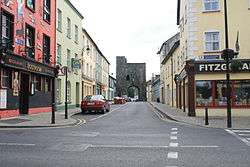 |
|||
| Limerick | County Limerick | |||
| New Ross | County Wexford | |||
| Rinn Dunn / Lecarrow | County Roscommon | The best preserved abandoned medieval town in Ireland | ||
| Trim | County Meath | |||
| Waterford | County Waterford |  |
||
| Wexford | County Wexford |  |
||
| Youghal | County Cork |  |
Italy

- Acuto
- Albenga - fragmentary remains, including stretches of wall and 3 town gates.
- Alghero
- Ancona
- Anghiari
- Aosta's Roman walls are still preserved almost in their entirety
- Appignano
- Aquasparta
- Arcevia
- Assisi
- Bagnacavallo - two town gates remain.
- Bari – historically a walled port city on a promontory but only two bastions and a short section of the sea walls survived
- Bassano del Grappa
- Bastia Umbra
- Belvedere Ostrense
- Bergamo surrounding hill of the old city
- Bologna
- Bozzolo
- Brescia – the castle hill (called Cidneo Hill) is surrounded by preserved medieval and Renaissance fortifications. Segments of Roman and venetian walls are partially survived
- Brindisi - several parts of the walls are preserved, including 5 bastions and two town gates, the Porta Lecce and the Porta Mesagne.
- Cagli
- Cagliari
- Camerino
- Capua
- Castel Bolognese - three wall towers still remain.
- Castel del Monte
- Castelfranco Veneto
- Castelvetro di Modena
- Castelsardo
- Castiglion Fiorentino
- Castiglione di Garfagnana
- Castiglione del Lago's old town has fully preserved walls
- Cesena
- Cingoli
- Cittadella
- Città della Pieve
- Città di Castello
- Colmurano
- Corinaldo
- Corridonia
- Cortona
- Crema
- Crotone
- Fabriano
- Faenza
- Falerone
- Fano – large sections of the Roman walls and towers are preserved. One town gate still remains, the Roman Arco di Augusto.
- Felizzano
- Ferrara
- Firenzuona
- Fiuggi
- Florence
- Foligno
- Forlì - remains include the ruins of the Porta Schiavona. The foundations of a tower can be found in the roundabout at the Piazza Santa Chiara.
- Gallipoli
- Genoa has partial fortifications still standing
- Glurns Glorenza in Italian
- Gradara
- Grosseto's star shaped town walls are almost completely intact.
- Guardiagrele
- Guastalla - a star shaped road around the town indicates the trace of the fortifications. A wall tower still stands at the corner Via Giuseppe Verdi/Via Volturno.
- Iglesias
- Isernia
- Jesi
- Lanciano
- Lecce
- Leonessa
- Loano
- Loro Piceno
- Lucca
- Macerata
- Marostica - The defensive walls around the old town are fully intact. The walls are among the best preserved medieval defensive structures in Italy. Including 3 town gates, 20 towers and two castles, the Castello Superiore and the Castello Inferiore.
- Marsala
- Marta
- Massa Fermana
- Matera
- Melfi
- Messina - see Fortifications of Messina
- Mignano Monte Lungo - the Porta Fratte town gate is the only remain of the medieval town walls.
- Mondolfo
- Montefalco
- Montegiorgio
- Montagnana
- Montappone - small fortified town. The town directly borders the walled town of Massa Fermana]]
- Montecassiano
- Montecatini Terme
- Monte San Giusto - fragmentary remains, including an impressive town gate and a tower.
- Monte San Pietrangeli
- Monte San Savino
- Monte Vidon Corrado
- Muggia - remains include two towers, two stone bastions, two town gates and large stretches of the walls.
- Naples
- Nardò - several fragments of the walls still stand around the town, including many towers which are incorporated in houses.
- Narni
- Nettuno
- Noale
- Norcia
- Orbetello
- Orvieto
- Ostra
- Otranto
- Padova
- Palmanova has fortress plan and structure, called a star fort it is a nine pointed citadel
- Passignano Sul Trasimeno
- Pavia
- Perugia
- Petriolo
- Piacenza has large sections of its Renaissance walls still standing
- Piglio
- Piombino
- Pisa
- Pistoia
- Pollenza
- Pontremoli
- Portoferraio
- Potenza Piceno
- Pozzuoli
- Prato
- Procida
- Reggio Emilia - very little remains of the medieval town walls. One town gate remains, the impressive Porta Santa Croce. A stretch of wall is located at the Viale Monte Grappa.
- Rapagnano
- Rapolano Terme
- Ravenna
- Rome has walls since the Roman Empire
- Rieti
- Rimini
- San Costanzo, Pesaro e Urbino - one of the smallest fortified towns in Italy
- San Gimignano
- San Severino Marche
- Santarcangelo di Romagna – most of the medieval town wall remains around the olt town, including long stretches of wall, a gate and several towers.
- Sabbioneta
- Sansepolcro
- Sant'Angelo in Pontano
- Sassari fragmentary remains, mainly at the north side of the old town.
- Savignaro Sul Panaro
- Sciacca
- Senigallia
- Serra De'Conti
- Siena
- Soncino
- Spilamberto - one town gate still remains.
- Spilimbergo - one town gate remains, the Porta Orientale.
- Spoleto
- Staffolo
- Sulmona
- Susa - fragmentary remains of Roman walls. The cathedral is built against the side of the Roman town gate Porta Savoia. Several parts of the walls and three lowered towers can be found alongside the Corso Unione Sovietica.
- Tarquinia
- Termoli
- Terra del Sole almost all town walls remain, with four bastion and two gate (Porta Romana and Fiorentina). Ideal-town of renaissance
- Todi
- torre San Patrizio
- Trapani
- Treia
- Trevi
- Treviso
- Tuscania
- Urbino
- Urbisaglia
- Verona
- Vicenza large sections of the town walls still remain, mainly alongside the Viale Giuseppe Mazzini, Via Goivanni Cecciarini and the Via Legione Gallieno. Four town gates remain, the Porta San Bortolo, Porta Santa Lucia, Porta Castello and the Porta Santa Croce.
- Volterra
- Vaste
Latvia
- Riga – the best preserved part of the old town walls is the Powder Tower. Just north west of the Powder Tower remains a stretch of wall with a square tower. Foundations of the wall can be seen at Kalēju iela street, and there are fragments of a ruined wall at the site of a demolished building at Minsterejas iela street. The only remains of the earthen ramparts around the old town is a star shaped moat, now transformed into a park.
- Cēsis (see Cēsis Castle)
- Daugavpils Fortress (Not a true walled city, but a huge fortress with buildings)
Lithuania
Luxembourg
Macedonia
Malta
| Place | Region | Condition | Image | Notes |
|---|---|---|---|---|
| Birgu | South Eastern Region | Intact | Main article: Fortifications of Birgu An ancient Castrum Maris stood in Birgu since the 13th century. This was rebuilt as Fort St Angelo in the 16th and 17th centuries, when walls surrounding the entire city were built. Most of the fortifications are intact, except for a small part which was destroyed in a magazine explosion in 1806. | |
| Cittadella | Gozo Region | Intact | 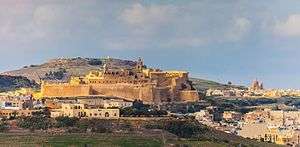 |
The area was first fortified in the Bronze Age, and was one of the earliest settlements on the Maltese islands. The town as it is today was fortified by the Aragonese and the Order of Saint John in the 15th to 17th centuries. Half of the town itself is in ruins, although the walls surrounding it are intact. |
| Cospicua | South Eastern Region | Mostly intact |  |
Main articles: Santa Margherita Lines and Cottonera Lines The fortifications were built by the Order of Saint John in the 17th and 18th centuries. The city was heavily bombed in the Second World War, but its fortifications remain largely intact although they are in need of restoration. |
| Floriana | South Eastern Region | Mostly intact | _02_ies.jpg) |
Main article: Floriana Lines The area was fortified in the 17th century when the Floriana Lines were built. The walls remain largely intact, although in a rather dilapidated state. |
| Mdina | Northern Region | Intact | 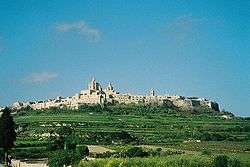 |
Main article: Fortifications of Mdina The town was first fortified by the Phoenicians, and the current fortifications are based on those built by the Arabs in the 9th to 11th centuries. The fortifications were extensively modified in the Middle Ages, and then by the Order of Saint John until the 18th century. The walls were recently restored, and they are some of the best preserved fortifications in Malta. |
| Senglea | South Eastern Region | Partly intact |  |
Main article: Fortifications of Senglea The town was fortified in the 1550s by the Order of Saint John. Most of its fortifications including Fort Saint Michael were dismantled in the 19th and 20th centuries, and the walls sustained damage in World War II. However, some still survive to this day, including the impressive seaward bastions and part of the land front. |
| Valletta | South Eastern Region | Intact | _01_ies.jpg) |
Main article: Fortifications of Valletta The fortifications of Valletta were built by the Order of Saint John between 1566 and 1571, and continued to be modified several times in the following centuries. The City Gate was rebuilt five times, the latest one being completed in 2014. The fortifications of Valletta remain intact, except for a lunette that was demolished in the 19th century and some breaches in the walls. |
Monaco
Montenegro
- Kotor
- Bar
- Budva
- Herceg Novi
- Kotor - built by Illyrian tribes in the 9th century and enlarged many times from the 13th century until the 19th century.
- Podgorica
- Sveti Stefan
- Ulcinj
Netherlands
| Place | Province | Accessible | Condition | Image | Notes |
|---|---|---|---|---|---|
| 's-Hertogenbosch | Noord Brabant | Yes | Sizable parts of the fortifications remain intact. |  |
Of the first city wall, built in the 13th century, one tower, belonging to one of the city gates, remains incorporated in a house on the Hinthamerstraat. Another remnant of the first city wall is formed by a gate over one of the arms of the Binnendieze River near the Korte Waterstraat. Sizable sections of the second, 13th-century city walls, and 17th- and 18th-century bastions remain intact as they serve as flood prevention measures. Of special note is the 17th-century pentagonal citadel. |
| Aardenburg | Zeeland | Vestiges of the fortifications are visible in the landscape. |  |
In 1625 AD, a new trace of earthen ramparts was built. These defenses were demolished between 1688 and 1701 AD. One city gate, the Westpoort, survives. Additionally, remnants of bastions, ravelins, and other outworks are clearly distinguishable in the fields surrounding the town. The foundations of a Roman gatehouse with 2 towers can be found at the Burchtstraat. The foundations of a Roman tower are now incorporated in the playground of a local school. | |
| Amersfoort | Utrecht | Yes | Sizable parts of the fortifications remain intact. |  |
Of the first 13th-century city wall, one tower and the barbican of one gate, the Kamperbinnenpoort, remain. After the enlargement of the city in 1450 AD, houses were built on the location of the first wall, and occasionally incorporating fragments of that wall in their structure. Of the 15th-century wall, several stretches remain to the north-east of the old town, while the foundations of the wall have been made visible on the south-eastern side. Two 15th-century gates remain as well; the koppelpoort, a combined land and water gate, and the Monnickendam, a water gate. |
| Amsterdam | Noord Holland | One or more individual structures (Bastions, gates, towers, etc.) remain. |  |
Of the medieval walls, the Sint Antoniuspoort is the most important remnant. Other remnants of the same wall are the Schreierstoren and the lower part of one of the towers of the former Regulierspoort. Of the later Baroque defenses, only the Muiderpoort remains intact, while some of the bastions can still be recognizable in the bendy course of the outer moat that still surrounds the old town. The most recent defensive structure around the city is the Stelling van Amsterdam, a 135 km long ring of fortifications around Amsterdam, consisting of 42 forts and other works. | |
| Arnhem | Gelderland | One or more individual structures (Bastions, gates, towers, etc.) remain. | Only the 14th-century Sabelspoort remains. | ||
| Asperen | Gelderland | One or more individual structures (Bastions, gates, towers, etc.) remain. |  |
On the side of the Linge River, a stone wall, incorporating the bases of several towers, remains. The water gate, giving access to the old harbor, is partially reconstructed. On the land side, parts of earthen ramparts and moats remain. | |
| Bergen op Zoom | Noord Brabant | Yes | One or more individual structures (Bastions, gates, towers, etc.) remain. |  |
Of the medieval fortifications, only the 14th-century Gevangenpoort remains. Of the extensive 17th-century fortifications, only one single ravelin remains. |
| Bolsward | Friesland | Yes | One or more individual structures (Bastions, gates, towers, etc.) remain. | A moat still encloses the town center. | |
| Bourtange | Groningen | Yes | The fortifications were recently reconstructed. |  |
The original fortifications were demolished in the 19th century, but have been reconstructed from 1960 onwards, in a successful effort to revitalize the village. |
| Breda | Noord Brabant | One or more individual structures (Bastions, gates, towers, etc.) remain. |  |
The only notable remnant of the city walls is the Spanjaardsgat gate; a water gate defended by two multiangular towers. It forms part of the defenses around Breda Castle, which in turn formed an integral part of the city walls. | |
| Bredevoort | Gelderland | Yes | One or more individual structures (Bastions, gates, towers, etc.) remain. | Part of the ramparts, located on the north-east of the town, have been reshaped into a park. To the south-west, a windmill stands on top of a remnant of one of the bastions. | |
| Brielle | Zuid Holland | Yes | The city wall remains intact. |  |
The old town is completely enclosed by earth ramparts, featuring nine bastions, as well as multiple outer works. |
| Brouwershaven | Zeeland | Yes | One or more individual structures (Bastions, gates, towers, etc.) remain. | Part of the ramparts, located on the east and north of the town, remain intact. | |
| Buren | Gelderland | Yes | Sizable parts of the fortifications remain intact. |  |
On the east side of town, facing the river, an impressive wall remains. On the north-west side of the town, a city gate remains, flanked by a row of houses built against the old town wall. |
| Culemborg | Gelderland | One or more individual structures (Bastions, gates, towers, etc.) remain. | The old town, its medieval extensions, and the site of the old castle, are still surrounded by a moat. Of the oldest, the 14th-century city wall, one city gate remains, while several fragments of the city wall stand on the south and east sides of the old town. | ||
| Delft | Zuid Holland | One or more individual structures (Bastions, gates, towers, etc.) remain. |  |
The old town is for the most part still surrounded by a moat. Along this moat stand two towers belonging to the medieval wall. On the eastern end of the old town stands the Oostpoort, a 15th-century combined land and water gate. | |
| Doesburg | Gelderland | Yes | Sizable parts of the fortifications remain intact. | The fortifications around the old city have been demolished, but the advanced line of defenses to the east of the city remains intact as part of a nature reserve. | |
| Dokkum | Friesland | Yes | The city wall remains intact. |  |
The old city is completely enclosed by a line of earth ramparts, featuring five bastions. |
| Dordrecht | Zuid Holland | One or more individual structures (Bastions, gates, towers, etc.) remain. | 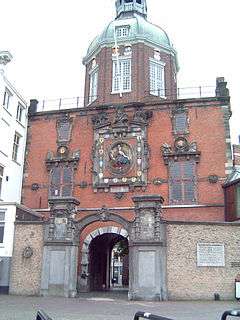 |
The old city is completely enclosed by a moat, while the old harbor is guarded by the Groothoofdspoort, a late medieval city gate, later rebuilt in a Renaissance style. | |
| Elburg | Gelderland | Yes | Sizable parts of the fortifications remain intact. | The old city is completely enclosed by a moat and a 16th-century rectangular earthen rampart with a bastion at each corner. The rampart was changed into a park in the 19th century, but the defenses are still easily recognizable. Several of the old gates were defended by a barbican, the lower parts of which have been excavated and the casemates of one of the barbicans can be visited. Several sections of the medieval city wall still stand behind the 16th-century rampart. One tower of the medieval wall had been changed into a gate in the 16th century. This structure forms the last remaining city gate of the old town. | |
| Enkhuizen | Noord Holland | Yes | Sizable parts of the fortifications remain intact. |  |
The landward side of the old town is still completely surrounded by an earthen rampart with five bastions. The last remaining gate facing the landward side of the city is the 17th-century Koepoort. The most impressive remnant of the fortifications is the 16th-century 'Drommedaris' gate, which stands near the harbor. |
| Franeker | Friesland | One or more individual structures (Bastions, gates, towers, etc.) remain. |  |
The old city is completely enclosed by a moat. The locations of the old bastions and bulwarks are still recognizable in the shape of the moat. | |
| Gennep | Limburg | Sizable parts of the fortifications remain intact. | Lowered remnants of the old city walls surround the west and north sides of the old town. | ||
| Geertruidenberg | Noord Brabant | Yes | Sizable parts of the fortifications remain intact. |  |
Most of the fortifications were demolished, but restored sections of the bastioned trace remains to the north and east sides of the old town. |
| Goes | Zeeland | One or more individual structures (Bastions, gates, towers, etc.) remain. |  |
The old city is completely enclosed by a moat. The locations of the old bastions and bulwarks are still recognizable in the shape of the moat. | |
| Gorinchem | Zuid Holland | Yes | The city wall remains intact. |  |
The old city is completely enclosed by an intact city wall. To the west of the city, the bastioned trace was demolished in order to accommodate the construction of a canal. The defences on that side were subsequently replaced by a Caponier. |
| Gouda | Zuid Holland | One or more individual structures (Bastions, gates, towers, etc.) remain. | 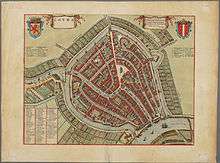 |
The old city is completely enclosed by a moat. The remains of a town gate are located near a street named Bogen, meaning 'Arcs', named after the arcs built in the medieval town wall which its trace once ran alongside the Turfsingel side of the street. A part of the town wall is located at the corner Oosthaven with Nieuwe Veerstal. This part of the walls itself once was a part of Gouda castle. Other remains of the castle include subterraneans, cellars and fundaments of walls and touwers arel located in the Houtmanplantsoen, behind the nearby windmill. The lower part of this windmill is a remnant of one of the castle's towers. | |
| Grave | Noord Brabant | One or more individual structures (Bastions, gates, towers, etc.) remain. |  |
Fragments of the double system of moats remain, as well as one city gate. The lower portions of several round medieval towers can be seen at the old harbor. The water gate, leading down to the river Maas, is a recent reconstruction. | |
| Groenlo | Gelderland | Yes | One or more individual structures (Bastions, gates, towers, etc.) remain. | 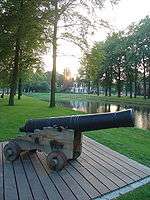 |
The old town is partially surrounded by an old moat, which clearly shows the locations of the old bastions. Part of the bastionned trace has been reconstructed. |
| Groningen | Groningen | One or more individual structures (Bastions, gates, towers, etc.) remain. | .jpg) |
The old town is surrounded by a moat. | |
| Haarlem | Noord Holland | One or more individual structures (Bastions, gates, towers, etc.) remain. |  |
The old city centre is still partially surrounded by a moat. To the north of the city, the moat clearly shows the locations of the old bastions, which have been changed into a park. One city gate remains; the 14th-century Amsterdamse Poort.\ | |
| Hardenberg | Overijssel | Vestiges. | The only remnant of the medieval town walls is a small lowerd part of a wall at the western end of the Wilhelminaplein, next to an old water pump. | ||
| Harderwijk | Gelderland | One or more individual structures (Bastions, gates, towers, etc.) remain. | Several sections of the old medieval wall remains, the most sizable parts being located to the north of the old city, facing the former Zuiderzee. Two gates, the Vischpoort and the Smeepoort, stil remain. The Vischpoort has a lighthouse installed on the roof. | ||
| Harlingen | Friesland | One or more individual structures (Bastions, gates, towers, etc.) remain. | Several sections of the moat, indicating the presence of three of the old bastions, remain on the east side of the city. | ||
| Hasselt | Overijssel | One or more individual structures (Bastions, gates, towers, etc.) remain. | On the landside of the city, remnants of the ramparts, featuring four sizable bastions, remain incorporated in a park. | ||
| Hattem | Gelderland | One or more individual structures (Bastions, gates, towers, etc.) remain. |  |
On the landside of the old town center some remnants of the city walls remain. On the side of the old town facing the river IJssel, the Dijkpoort can be found. | |
| Hellevoetsluis | Zuid Holland | Yes | The city wall remains intact. |  |
The old navy harbor is still entirely surrounded by a bastionned trace, which is outfitted with a brick revetment on the side of the walls facing the river. |
| Heukelum | Gelderland | One or more individual structures (Bastions, gates, towers, etc.) remain. | The town is still enclosed by a moat on the three sides facing away from the river Linge. | ||
| Heusden | Noord Brabant | The fortifications were recently reconstructed. | The city walls had been slighted in the 19th century, but have been extensively reconstructed during the middle of the 20th century. | ||
| Hoorn | Noord Holland | One or more individual structures (Bastions, gates, towers, etc.) remain. |  |
The old town is still surrounded by a moat. One city gate remains, the 16th-century Oosterpoort. The most notable remnant of the city defenses, however, is the Hoofdtoren, an impressive 16th-century tower, built to defend the harbor. | |
| Hulst | Zeeland | Yes | The city wall remains intact. | The old town is still surrounded by a rampart and a moat. Several remnants of outer works, such as ravelins and an outer wall, remain. | |
| IJzendijke | Zeeland | One or more individual structures (Bastions, gates, towers, etc.) remain. | Some fragments of the old moat remain. One ravelin belonging to the old fortifications has been restored | ||
| IJsselstein | Utrecht | One or more individual structures (Bastions, gates, towers, etc.) remain. |  |
The old moat remains, while some remnants of the town wall remain on the south and east side of the old town. | |
| Kampen | Overijssel | One or more individual structures (Bastions, gates, towers, etc.) remain. |  |
The old moat remains, while the old earthen ramparts remain incorporated in a park. Three medieval city gates remain, two of which have been rebuilt in a renaissance style. The largest gate, the Kroonmarktpoort, retained its medieval appearance. | |
| Klundert | Noord Brabant | Yes | One or more individual structures (Bastions, gates, towers, etc.) remain. | Several sections of the ramparts and bastions remain intact to the north and south of the old town. | |
| Leerdam | Noord Brabant | Yes | One or more individual structures (Bastions, gates, towers, etc.) remain. |  |
The city wall remains intact on the side of the town facing the river Linge. |
| Leeuwarden | Friesland | One or more individual structures (Bastions, gates, towers, etc.) remain. | The old town is still entirely surrounded by a moat. Several bastions to the north of the old town have been changed into a park. | ||
| Leiden | Zuid Holland | One or more individual structures (Bastions, gates, towers, etc.) remain. | 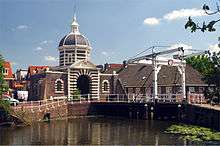 |
The old city is still surrounded by a moat. Of the city defenses, two city gates remain and one medieval tower stand to the south of the old town. Part of a bastion on the east side of the city has been reconstructed. | |
| Maastricht | Limburg | Yes | Sizable parts of the fortifications remain intact. |  |
Important parts of all major fortification systems remain intact. Of the first city wall, the Helpoort gate remains, as well as several important sections of the oldest 13th-century city wall. Important parts of the second medieval city wall remain on the east side of the old town, while extensive remnants of the complicated system of baroque fortifications can be found to the north. Additionally, a large network of underground communication tunnels, casemates, and countermines remain underneath the present outskirts of the city, which were built on top of the old city walls. |
| Megen | Noord Brabant | One or more individual structures (Bastions, gates, towers, etc.) remain. | Only a single 14th-century tower, known as the Gevangenpoort, remains. | ||
| Middelburg | Zeeland | Yes | One or more individual structures (Bastions, gates, towers, etc.) remain. |  |
The bastioned trace of the city wall has been changed into a park and is still surrounded by a moat. Only one city gate remains, the 18th-century Koepoort. |
| Montfoort | Utrecht | One or more individual structures (Bastions, gates, towers, etc.) remain. |  |
One of the medieval city gates has been incorporated into the town hall. Another remaining portion of the town wall remains to the south west of the old town. | |
| Muiden | Noord Holland | Yes | Sizable parts of the fortifications remain intact. |  |
The 16th-century town walls were greatly adapted in the 19th century, when the town became part of the advanced defenses of Amsterdam. The city walls located to the west of the river Vecht remain intact, as do the walls around the Muiderslot castle. |
| Naarden | Noord Holland | Yes | The city wall remains intact. |  |
Naarden is one of the best preserved fortified cities in Europe, featuring a double system of moats and walls, built in the 17th century. The inner wall features numerous underground tunnels, casemates, and barracks. |
| Nieuweschans | Groningen | Vestiges of the fortifications are visible in the landscape. |  |
The walls of the tiny fortified village have been partially demolished, although a small section remains. | |
| Nieuwpoort, South Holland | Zuid Holland | Yes | The city wall remains intact. | The tiny town is entirely surrounded by an earth rampart featuring six bastions and a false bray in front of the curtain walls. The town hall is built over a canal running through the center of town and defends a system of locks with which the land surrounding the fortress could be inundated. | |
| Nijmegen | Gelderland | Sizable parts of the fortifications remain intact. | Sizable parts of the medieval city walls remain to the west and east of the old city. The most notable remnant is the wall, and three towers, located in the Kronenburger park. Of the three towers, the Kronenburger tower is arguable one of the most impressive medieval towers in the Netherlands. | ||
| Ootmarsum | Overijssel | Vestiges. | The old town is still fully enclosed bij two ringroads, called the Westwal (Western wall0 and the Oostwal (Eastern wall), indicating the trace of the medieval walls. | ||
| Oudeschans | Groningen | Yes | Sizable parts of the fortifications remain intact. | .jpg) |
The walls of the tiny fortified village have been partially demolished, but remain very recognizable. Part of the city walls have subsequently been reconstructed in the 20th century. |
| Oudewater | Utrecht | One or more individual structures (Bastions, gates, towers, etc.) remain. |  |
The old city is enclosed by a moat. The locations of some of the old bastions and bulwarks are still recognizable in the shape of the moat. | |
| Philippine | Zeeland | Vestiges of the fortifications are visible in the landscape. |  |
Remnants of bastions, ravelins, and other outworks are clearly distinguishable in the fields surrounding the town. | |
| Ravenstein | Noord Brabant | One or more individual structures (Bastions, gates, towers, etc.) remain. |  |
A moat surrounds much of the old town, clearly showing the location of bastions and ravelins. The remnants of two hornworks are visible to the north and south of the old town. The side of the town facing the river Maas features the remnants of two bastions, excavated from the body of the dyke, as well as the single remaining city gate. | |
| Retranchement | Zeeland | Yes | The city wall remains intact. |  |
Retranchement was built in 1604 AD as an entrenched camp, consisting of two small, square forts, connected by a wall with three bastions. The northern fort no longer exists as it was destroyed in a flood in 1682 AD. |
| Rhenen | Utrecht | One or more individual structures (Bastions, gates, towers, etc.) remain. |  |
Lowered fragments of the 14th-century city wall can be found to the south of the old town. To the north, a windmill stands on top of a remnant of the wall. On the eastern entrance of the old town, the remnants of a sizable barracane can be found. | |
| Roermond | Limburg | One or more individual structures (Bastions, gates, towers, etc.) remain. |  |
Several fragments of the medieval city wall remain. The most notable and best preserved remnant is the Rattentoren, a 14th-century round tower standing on the north side of the old town. | |
| Sas van Gent | Zeeland | One or more individual structures (Bastions, gates, towers, etc.) remain. |  |
Of the once powerful and strategic fortress, very little remains. Most of the fortifications were demolished in 1930. What remains are the remnants of one bastion, upon which the base of an old windmill stands, and the remnants of an old late 17th-century tidal mill, which was built into the fortifications. | |
| Schiedam | Zuid-Holland | One or more individual structures (Bastions, gates, towers, etc.) remain. | Parts of the moat remain, including the northern and western part. The famous Schiedam windmills are built on top of the bases of wall towers. | ||
| Schoonhoven | Zuid Holland | Yes | One or more individual structures (Bastions, gates, towers, etc.) remain. |  |
Only a fragment of the old moat remains on the landward side of the town. On the riverside stands the Waterpoort, the last remaining city gate, with some adjacent stretches of the old town walls. |
| Sittard | Limburg | Yes | Sizable parts of the fortifications remain intact. | The powerful fortress town was destroyed by French forces in 1677 AD. Sizable remnants of the medieval city wall remain, buried underneath a later earthen rampart which still surrounds most of the old town. | |
| Sluis | Zeeland | Yes | The city wall remains intact. |  |
The old town of Sluis was completely destroyed in the second world war, but he extensive fortification system remained intact and can still be visited today. |
| Sloten | Zeeland | Yes | Sizable parts of the fortifications remain intact. | The tiny fortress town of Sloten is still mostly surrounded by its ramparts, while the moat still completely encircles the town. Two water gates remain intact at the places where an old canal dissects the town. | |
| Steenbergen | Noord Brabant | Vestiges of the fortifications are visible in the landscape. |  |
Some fragments of the old moat remain. The locations of the old bastions can be recognized by the course of the moat and the street pattern. Remnants of the outer works are distinguishable in the surrounding landscape. | |
| Steenwijk | Overijssel | Yes | Sizable parts of the fortifications remain intact. | Sizable parts of the moats and ramparts remain. | |
| Stevensweert | Limburg | Vestiges of the fortifications are visible in the landscape. |  |
Although the walls themselves have been demolished, the town was built as an ideal fortress, and features the characteristic spider web street pattern that many such towns were built with. Part of the city walls have been reconstructed from 2007 AD onwards. | |
| Tholen | Zeeland | Yes | One or more individual structures (Bastions, gates, towers, etc.) remain. |  |
The ramparts were changed into a park, but the moat is still present and four bastions are still recognizable. |
| Tiel | Zeeland | One or more individual structures (Bastions, gates, towers, etc.) remain. | Fragments of the moat remain, as well as one city gate. | ||
| Utrecht | Utrecht | Yes | One or more individual structures (Bastions, gates, towers, etc.) remain. |  |
The medieval city wall has been completely demolished. Remnants of three of the 16th-century Italian style bastions remain. The most complete bastion is Sonnenborgh. Most of the old city fortifications were changed into an English style landscape park in the 19th century. The Dutch Water Line forms a double ring of fortresses where it passes east of the city. |
| Valkenburg aan de Geul | Limburg | One or more individual structures (Bastions, gates, towers, etc.) remain. | Two city gates remain at the foot of the ruined castle. Part of the city wall remains to the west side of the old town. The small Den Halder castle was built around an old tower of the city wall. | ||
| Veere | Zeeland | Yes | Sizable parts of the fortifications remain intact. |  |
The Campveerse toren is a large medieval tower that still guards the entrance to the old harbor today. The later earth ramparts remain mostly intact, especially the enlargements built by order of Napoleon |
| Venlo | Limburg | One or more individual structures (Bastions, gates, towers, etc.) remain. |  |
Nearly nothing remains of the once extensive fortifications of Venlo. The most extensive remnant being a stretch of 14th-century wall known as the "Luif" | |
| Vianen | Utrecht | One or more individual structures (Bastions, gates, towers, etc.) remain. | 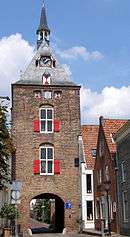 |
The Lekpoort is the last remaining city gate of the little town of Vianen. Apart from the gate, a large part of the town is still enclosed by a moat, while a sizable length of (lowered) city wall still stands on the south side of the town. | |
| Vlissingen | Zeeland | Yes | One or more individual structures (Bastions, gates, towers, etc.) remain. | Several remnants of bastions, curtain walls and a tower of a medieval city gate, still stand on the waterside. The landward facing defenses have all been demolished. | |
| Wageningen | Gelderland | One or more individual structures (Bastions, gates, towers, etc.) remain. |  |
The foundations of a small stretch of the medieval city wall have been unearthed and restored. Of the later ramparts, the moat remains, its trace clearly showing the locations of the old bastions. | |
| Weesp | Noord Holland | Yes | The city wall remains intact. |  |
Only four of the planned eight bastions were constructed. All four remain intact and surrounded by a moat. In the 19th century, a circular fort was constructed on an island in the river Vecht. |
| Willemstad | Noord Brabant | Yes | The city wall remains intact. |  |
In 1583 AD, prince William of Orange orders the construction of a fortified city on the location of the village of Ruigenhil. The city, called Willemstad, is still entirely surrounded by its seven sided city wall. |
| Wijk bij Duurstede | Utrecht | One or more individual structures (Bastions, gates, towers, etc.) remain. | A portion of the moat remains, as do several fragments of the city wall facing the riverside. One city gate still stands as a windmill has been built on top of it. The ramparts that surround the ruins of Duurstede castle have been reshaped into a landscape style park. | ||
| Woerden | Utrecht | Yes | One or more individual structures (Bastions, gates, towers, etc.) remain. |  |
Sizable sections of the inner and outer moats still remain and several of the bastions are still recognizable as such. The medieval castle still stands on the south eastern side of the old town. |
| Woudrichem | Noord Brabant | Yes | The city wall remains intact. | .jpg) |
The city received a set of strong ramparts with seven bastions in 1580 AD. Only one of the gates, the Gevangenpoort, now remains |
| Zaltbommel | Noord Brabant | Yes | Sizable parts of the fortifications remain intact. |  |
The earthen ramparts and its bastions were made into an English landscape park in the 19th century, but the structures remain intact up to a significant height and are easily recognizable. The outer moat still encloses the landward side of the city. Behind the earthen ramparts stand several sizable fragments of the medieval city wall. |
| Zierikzee | Zeeland | Yes | One or more individual structures (Bastions, gates, towers, etc.) remain. |  |
A moat still surrounds the old town. While the walls have been demolished, three medieval gates remain. Of these gates, the ensemble of the Noordhavenpoort and Zuidhavenpoort, which guard the entrance to the old harbor, form one of the most impressive remaining medieval defensive structures in the Netherlands |
| Zutphen | Gelderland | One or more individual structures (Bastions, gates, towers, etc.) remain. | 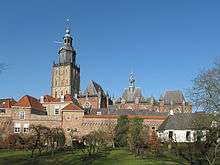 |
Remnants of moats from the medieval and post-medieval fortifications are still visible around the old town. The remnants of the medieval fortifications include several towers, the impressive Drogenapstoren gate, the Bourgonjetoren bastion, a water gate named Berkel gate, and a sizable stretch of the old city wall to the south of the old town. | |
| Zwolle | Overijssel | One or more individual structures (Bastions, gates, towers, etc.) remain. |  |
The moat, still clearly showing the remnants of the old bastions, still encloses the old town. The Sassenpoort is the sole remaining city gate, but is one of the largest and most impressive gates of the Netherlands. A number of fragments of the medieval city wall, including two strong towers, still stand along the waterside of the Thorbeckegracht |
Norway
- Fredrikstad
- Gamlebyen
- Oslo (Akershus Fortress)
Poland


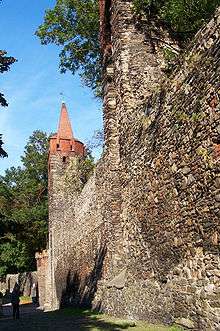


- Biała Prudnicka
- Bialogard
- Boleslawiec – the old town has fragmentary remains of the old town wall, including several towers and stretches of wall.
- Braniewo
- Brodnica
- Broumov
- Brzeg – a star shaped park around the old town is what remains of the reinassance fortifications. Some parts of the moat still remain. The shape of seven bastions is recognizable from the air.
- Bystrzyca Klodzka
- Chełmno – almost whole length of walls (2.2 km), with 17 watch towers and city gate, 13th and 14th centuries.
- Chojna
- Chojnice
- Dąbie
- Dzierzoniow
- Gdańsk
- Glogow
- Gniew
- Goleniów
- Golub-Dobrzyń
- Gorzów Wielkopolski
- Grodków
- Grudziadz
- Gryfice
- Gryfino
- Jawor
- Jelenia Góra
- Kalisz
- Kamień Pomorski
- Ketrzyn
- Klodzko – the remains include the impressive citadel located on a hill north of the medieval town.
- Kolobrzeg – a round basion and a part of the moat still remain.
- Kostrzyn – the medieval town was entirely destroyed during World War II, only remaining some ruins of houses, the ruins of a church and the riverside fortified walls. The fortified walls include three bastions and a land gate. The remaining moat of an outer work is located north west of the ruined medieval town.
- Koszalin
- Kowalewo Pomorskie
- Kożuchów
- Kraków – only the barbican, Floriańska Gate, two watch towers and some traces preserved
- Krapkowice
- Kwydzin
- Legnica
- Lębork – city ruins from the Medieval era
- Lidzbark Warmiński
- Lipiany
- Lubań – partially preserved
- Lubawa
- Lubin
- Lublin
- Malbork – one gate and a round bastion still remain. Stretches of the walls still remain alongside the river in the direction of the famous Malbork Castle
- Maszewo – the town walls are nearly complete, apart from two breaches made for the increasing traffic. The two original town gates are demolished, and an adjacent tower of one of the gates still remains.
- Mieszkowice
- Myślibórz
- Nowe – sizable parts of the walls remain.
- Nowe Miasto Lubawskie – two town gates remain.
- Nowogrodziec
- Nysa – there are large remains of the reinassance fortifications, notably to the east of the old town and to the north of the Nysa Klodzka river. There are several forts around Nysa. The remains of the medieval town walls include two land gates, the remains of a water gate, some towers and stretches of wall.
- Olkusz
- Olsztyn
- Opole – the remaining walls are located in the north east corner of the medieval town.
- Paczków – very well preserved walls with 19 towers and 3 gates
- Pasłęk – large stretches of the walls remain intact, including two city gates
- Poznań – city walls existed until the early 19th century (fragments remain); Prussian fortifications were built in the 19th century
- Prabuty
- Przemyśl – partially preserved ruins
- Pyrzyce – until World War II best preserved city walls in Pomerania region, from the 14th century
- Sandomierz
- Slupsk
- Sroda Slaska
- Stargard Szczeciński – significant parts survived with 3 gates (including unique water gate - Brama Młyńska); one of the most interesting city walls in Poland
- Starogard Gdański
- Strzegom
- Sulechow
- Susz
- Świebodzice
- Swiebodzin
- Syców
- Szczecin – to the east of the castle remains a well-preserved wall tower. Two town gates still remain.
- Szprotawa
- Szydłów – city walls with Krakowska Gate and watch towers built in the 14th century
- Tarnow
- Tczew
- Toruń – several watch towers, three city gates and some sections (the longest and most impressive from Vistula) from the 13th to 15th centuries
- Trzebiatow
- Trzcinsko-Zdroj
- Twierdza Modlin, or Modlin Fortress
- Warsaw – partially preserved, partially restored after World War II, barbican restored
- Wielun
- Wolin – only one bastion remains to the south of the town.
- Ząbkowice Śląskie
- Zagan
- Zamość – complete renaissance and 19th-century walls preserved
- Żary
- Zlotoryja
Portugal
- Almeida Vauban style fortress town.
- Bragança – the old town is still completely surrounded with medieval walls, including all 12 towers and two gates.
- Castelo de Vide
- Coimbra
- Évora
- Elvas - Elvas is among the finest examples of intensive usage of the trace italienne (star fort) in military architecture.
- Estremoz
- Lagos, Portugal
- Marvão
- Monção
- Monsaraz
- Monforte
- Óbidos
- Olivenza
- Peniche
- Setúbal - the remains of 5 bastions can be found around town.
- Valença
- Vide
Romania
- Alba Iulia
- Bistriţa
- Brașov
- Cluj-Napoca
- Constanța
- Mediaș
- Oradea
- Orăștie
- Sebeș
- Sibiu
- Sighișoara
- Timișoara
Russia

- Astrakhan
- Derbent
- Izborsk
- Ivangorod
- Kazan
- Kolomna
- Moscow
- Nizhny Novgorod
- Novgorod
- Porkhov
- Pskov
- St. Petersburg (Peter and Paul fortress town)
- Smolensk
- Shlisselburg
- Tobolsk
- Tula
- Vyborg
- Yaroslavl (only several towers still stand)
- Zaraysk
Serbia
- Belgrade – Kalemegdan
- Novi Sad – Petrovaradin
- Bač
- Manasija – Resava
- Niš
- Pirot
- Smederevo
- Golubac
- Maglič
- Šabac
Slovakia

- Banská Bystrica
- Banská Štiavnica – only one city gate left
- Bardejov – walls almost completely preserved, with bastions and barbican
- Beckov
- Bojnice – large parts of the wall preserved, together with one of the city gates
- Bratislava – only few structures have survived from original fortifications.
- Brezno
- Fiľakovo
- Komárno – baroque fortifications almost completely preserved
- Košice
- Kremnica – about two thirds of the defensive walls around the town preserved, with several bastions and the city gate with barbican.
- Krupina
- Levice – parts of the defensive walls were found during an archaeological survey
- Levoča – almost completely preserved
- Modra – about two thirds of the walls still standing, one bastion and one of the city gates
- Nové Zámky
- Pezinok – parts of the defensive walls visible on several locations of the town
- Podolínec
- Pukanec
- Prešov – parts of the defensive walls were found during an archaeological survey
- Sabinov
- Skalica – large parts preserved
- Spišská Kapitula
- Svätý Jur
- Trenčín – parts of the defensive walls were found during an archaeological survey
- Trnava – mostly preserved, with several bastions and one city gate
- Zvolen
- Žilina
Slovenia
- Celje
- Koper
- Kranj - evidence of the 1st century fortifications and parts of the medieval fortifications, with four of the original eight towers preserved
- Ljubljana - In the 1st century AD, a Roman settlement called Emona, on the site of the present day Ljubljana, was fortified with strong walls. A small section of the southern wall is still preserved to this day. Ljubljana got it's medieval walls, like many other towns in Slovenia, in the 13th century
- Maribor - 13th century fortification, some segments of which, including four of the towers, are still preserved. The walls of Maribor withstood sieges by Matthias Corvinus in 1480/1481 and by the Ottoman Empire in 1532 and 1683
- Novo mesto
- Piran - 7th century fortification, expanded between 1470 and 1533
- Ptuj - 13th century fortification
- Slovenj Gradec
- Škofja Loka
- Vipavski Križ
Spain
- Aínsa
- Alarcón
- Albarracín
- Alburquerque
- Alcalá de Henares - has preserved 1,200 metres of walls dotted with 19 towers
- Alcántara, Cáceres
- Alcúdia
- Almazán
- Alquézar
- Artajona
- Astorga
- Atienza
- Ávila - has the most complete medieval walls in Spain, half of which is navigable on foot
- Badajoz - has medieval walls and most of its renaissance fortress
- Balaguer
- Barcelona - has portions of a Roman wall
- Béjar
- Berlanga
- Berlanga de Duero
- Besalú
- Brihuega
- Buitrago del Lozoya - has complete medieval walls.
- Burgos - has some sizable remaining parts of the town walls alongside the Paseo Cubos and to the north east of the castle, including 10 wall towers. There are also remaining towers at the Calle Trinidad and the Calle San Lesmes. Five gates still remain intact, the Arco de Santa Maria, the Arco San Martin, the Arco de San Esteban, the Arco de San Gil and the Arco de San Juan
- Burgo de Osma-Ciudad de Osma
- Cáceres
- Campo Maior
- Cartagena
- Castellar de la Frontera
- Ceuta
- Ciudad Rodrigo - suffered several sieges in Napoleonic wars, walls remain intact
- Ciutadella de Menorca
- Coca, Segovia
- Córdoba
- Coria – the old town is still completely surrounded by medieval walls
- Covarrubias, Province of Burgos
- Cuéllar
- Cuenca
- Daroca
- Frías, Province of Burgos
- Galisteo – the town walls are completely preserved
- Gijon
- Girona
- Granada
- Zarza de Granadilla
- Haza, Province of Burgos
- Hondarribia
- Huesca fragmentary remains
- Ibiza
- Jerez de los Caballeros
- Laguarda
- Laredo - two town gates still remain, the Puerta de Merenillo and the Puerta de Bilbao
- Llanes
- León - has an almost complete set of Roman walls dating back to the 3rd century AD, besides some parts built during the Middle Ages
- Loarre
- Lugo - has completely intact Roman walls. It is protected by UNESCO as a World Heritage Site
- Maderuelo
- Walls of Madrid - five walls
- Madrigal de las Altas Torres
- Málaga
- Mansilla de las Mulas
- Mataró
- Medina del Campo - fragmentary remains
- Melilla - the old town is still fully enclosed by its impressive medieval walls
- Mirambel
- Molina de Aragón
- Montblanc
- Montfalco Murallat
- Mora de Rubielos
- Morella
- Niebla, Huelva
- Olivenza - the oldest part of the town, the area adjacent to the medieval castle of Olivenza, still has well-preserved stretches of walls and towers, including two original town gates. Large parts of the later star-shaped Renaissance fortifications are also preserved, including 9 bastions and 1 town gate, the Puerta del Calvario
- Olmedo
- Oviedo - has preserved parts of its medieval walls
- Palazuelos
- Palma, Majorca
- Pamplona
- Pedraza, Segovia
- Peniscola
- Plasencia
- Portillo, Valladolid - fragmentary remains
- Rada
- Rello
- Requena
- Ronda - has almost complete walls (not counting the gorge which defends it on one side)
- Salamanca
- San Vicente de la Barquera - the old town has preserved the walls along with the castle
- Santander – the old town had medieval defensive walls. A stretch of wall alongside Calle de Cadiz is all that remains
- Santillana del Mar – there are fragmentary remains of the medieval walls, including a stretch of wall alongside a car park southeast of the old town and a tower at the Plaza las Arenas facing to the north
- Sasamón
- Segovia - preserves parts of the wall plus three gates
- Sigüenza
- Talavera de la Reina
- Tarifa
- Tarragona
- Tiedra - vestiges
- Toledo
- Tortosa - large parts of the extensively fortified medieval town remain intact
- Tossa de Mar
- Urueña
- Valencia - preserves portions of a Muslim wall and towers from Christian medieval age
- Valladolid - vestiges
- Vitoria-Gasteiz - fragmentary remains
- Xàtiva
- Zamora – the old town walls remain largely intact, especially at the north, west and riverside of the old town.
- Zaragoza
Sweden
- City wall of Visby
- Gothenburg has a part of the western city wall left, the bastion Carolus Rex at Esperanto platsen (Esperanto square) and most of the city moat is still left.
- Halmstad had reinassance ramparts. To the north of the old town a bastion with adjacent town gate remains, the Norre Port. To the south of the old town a bastion with a remnant of the moat remains.
- Kalmar substantial remains of the walls. Sizable stretches of walls and a bastion remain to the south of the old town. To the east remain two bastions. To the north remain portions of wall near Fiskaregatan. To the west the shape of two bastions is clearly recognizable, with a ravelin in front of the remaining town gate Westport (Westgate). Two other town gates still remain, an unnamded gate of later date at the Skeppsbrogatan, and a gate at Skeppsbron.
- Stockholm has a small remainder of the medieval city wall preserved.
- Bohus Fortress
Switzerland
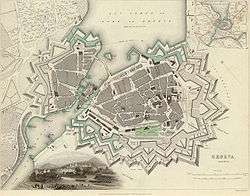
- Aarau – the remains of the medieval town walls include two town gates (the Haldertor and the Oberer Turm) and a tower (the Pulverturm) with an adjacent stretch of wall.
- Altstätten
- Arbon – the remains include some fragments of wall and a tower converted into a house.
- Avenches
- Baden
- Basel
- Bellinzona (Dominated by its three castles: Castelgrande, Castello di Montebello and Castello di Sasso Corbaro)
- Biel
- Bremgarten
- Brugg
- Bülach
- Chur
- Delémont
- Diessenhofen
- Frauenfeld
- Fribourg
- Geneva
- Greifensee
- Grüningen
- Gruyères
- Ilanz
- Laufen, Basel-Landschaft
- Lausanne
- Lenzburg
- Liestal – one town gate remains.
- Lucerne – the wall on the northern bank of the Reuss is well preserved and among the principal landmarks of the city.
- Maienfeld
- Meienberg, Sins, Aargau
- Morges
- Münchenstein
- Murten: Medieval walls
- Neufchatel
- Nyon
- Olten
- Orbe
- Rapperswil
- Regensberg
- Rheinfelden
- Romont
- Schaffhausen
- Sempach
- Solothurn – large parts still remain, including several walls, towers and a bastion. Two town gates remain, the impressive Baseltor and the Bieltor.
- Steckborn
- Sursee
- Thun
- Uznach
- Wangen an der Aare
- Werdenberg
- Wiedlisbach
- Willisau
- Winterthur
- Yverdon-les-Bains
- Zofingen
- Zug – the only remainder of the inner town walls is the Zeitturm (Clocktower), a medieval town gate. The remains of the outer town walls include four towers (the Kapuzinerturm, Knopfliturm, Huwilerturm and the Pulverturm), and some stretches of wall.
- Zurich – the main remains are the Schanzengraben, and the shapes of several bastions are recognizable through the course of the moat. One bastions remains largely intact, and it now houses the Alter Botanischer Garten.
Turkey
.jpg)
- Troy. The ancient city of Troy was famous for its defensive walls. There is archaeological evidence that Troy VII, generally identified as the stage of the legendary Trojan War of Homer's Iliad, usually dated between 1194 BC – 1184 BC, had walls with a carefully built stone base over four meters thick and some nine meters high in places, which was surmounted by a larger superstructure with towers in mudbrick. The walls in Homer's epic are so mighty that the siege of Troy by Achaeans lasts more than nine years, and only could be finished with the trickery of the Trojan Horse. Sections of the stone base of Trojan walls still survive on the archaeological site in present-day Hisarlık, in Çanakkale province.
- Istanbul. The system of walls around (as it was then known) Constantinople built in 412 by the Roman emperor Theodosius II was a complex stone barrier that stretched 6.5 kilometers and is often called the Wall of Theodosius. This barrier stood impregnable for ten centuries and resisted several violent sieges until 1453 when the Ottomans succeeded in breaching the walls. There was a new element in the battlefield: the Ottoman army had powder cannon and the walls offered limited resistance to them.
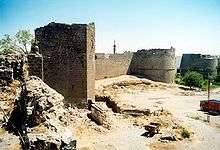
- Diyarbakır. Diyarbakır is surrounded by an almost intact, dramatic set of high walls of black basalt forming a 5.5 km (3.4 mi) circle around the old city. There are four gates into the old city and 82 watch-towers on the walls, which were built in antiquity, restored and extended by the Roman emperor Constantius in 349.
- Osmangazi
- Ankara
- Canakkale
- Iznik
- Antalya
- Sinop
- Rize
- Amasya
- Bodrum
- Alanya
- Ani
- Kusadasi
- Assos
- Bozcaada
- Edirne
- Enez
Ukraine
- Bilhorod-Dnistrovskyi
- Letychiv (see Letychiv Fortress)
- Lutsk (see Lubart's Castle)
- Lviv (see Hlyniany Gate)
- Medzhybizh (see Medzhybizh Fortress)
- Uzhhorod (see Uzhhorod Castle)
United Kingdom
England
- Alnwick Grade 1 listed Bondgate (Hotspur Gateway) and section of wall remain of mediaeval defences, Pottergate Tower is C18 rebuild of medieval gate and may incorporate some medieval fabric.[8]
- Bath – Several fragments of the medieval wall still survive. The East Gate is the only remaining gateway. The length of wall opposite the Mineral Water Hospital is largely a reconstruction of the medieval wall. By far the best length, over 160 ft, could until 1963 be seen on the site cleared by an air-raid in 1940. This was the SE corner of the medieval city. The remains of this wall now lie buried below the floor of the new Woolworths store.[9]
- Berwick-upon-Tweed – the Elizabethan ramparts with their bastions, gateways and earthworks survive. Spades Mire is an earthwork linear ditches, possibly forming an outer line of defence for medieval Berwick. Situated on the south side of the ditch are traces of an accompanying rampart, now much spread and up to 13m wide. The Lord's Mount is a massive curved stone bulwark which was built in the 1540s to protect the town walls at their weakest point.[10]
- Bridgnorth – the North Gate is still present, the site of the former Postern Gate still very visible; and parts of the wall now form garden walls in various parts of the town.
- Bristol traces and one fine city gate remain
- Canterbury
- Carlisle
- Chester – the city walls are one of the city's biggest tourist attractions. They were originally built by the Romans and continue to form a complete ring around much of the present-day city centre.
- Chichester

- Colchester – the town was surrounded by a wall built by the Romans after Boudica had sacked the town. Approximately half of the walls remain.
- Coventry – the walls were demolished in 1662. Two gates survive, connected by a section of wall that runs through Lady Herbert's garden. Other small fragments dotted around the city centre, mainly hidden by modern buildings, include the remains of a bastion near Upper Well Street. Several fragments have been incorporated into newer buildings.
- Durham – The Castle formed the largest part of Durham's defences, with the neighbouring "Backgate", demolished in the 1760s, which sat across Sadler Street. This was accompanied by a Gaol, which survived until the 1840s, remains of which are present in an alley off Sadler Street. Other walls surrounding the centre of Durham survive between the River Wear, and the houses lining a number of thoroughfares: Sadler Street, North Bailey, South Bailey, and Palace Green. The street names North Bailey and South Bailey are testament to this fact. It is debatable just how defensive these walls were, and some parts have since become garden walls. The archway of a Water Gate survives where South Bailey meets Prebends' Bridge.
- Exeter
- Great Yarmouth – about two-thirds of the wall remains. Of the original eighteen towers, eleven survive.
- Hartlepool
- Hereford
- Kingston upon Hull
- Leicester
- Lincoln – fragmentary remains
- London – fragments of London Wall, the wall that once surrounded the Roman town of Londinium, are still visible just outside the Museum of London and at Tower Hill in the City of London.
- Ludlow – good lengths of the wall remain and a number of the gates too
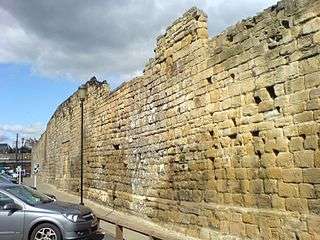
- Newcastle upon Tyne – much of the town wall was demolished during the late 18th and early 19th centuries but several sections still remain.
- Norwich
- Oxford – major fragments are preserved in the gardens of New College and Merton College and as part of the exterior wall of Pembroke College on Brewer Street.
- Rochester, Kent
- Rye
- Salisbury – around the original medieval city, including the cathedral and the close.
- Shrewsbury – one long section remains along the 'Town Walls' road; other shorter sections exist, such as behind Newport House on Dogpole, and near Shrewsbury Castle
- Silchester – the nearby deserted Roman town of Calleva Atrebatum has a complete set of walls.
- Southampton
- Wallingford
- Wareham
- Warwick
- Winchelsea
- Winchester "Walls fragmentary, but traceable throughout their length. Repaired in C14 and C15. Limestone rubble. South east corner of full height complete with battlements. Walls shared by the city, Wolvesey Palace, Cathedral Close and Wolvesey Castle. Two gates remain. Wall ran along line of Roman Wall."[11]
- Worcester – remains of the Worcester city walls can still be seen
- York – the extensive city walls are the longest and most complete in England, lacking only a few short sections and most of the posterns.
Northern Ireland
- Bangor, County Down
- Carrickfergus
- Derry walls withstood a siege during the Siege of Derry and are amongst the best preserved in Europe.
Scotland
- Dundee has only one remaining section of its city walls, first constructed in 1545, the Wishart Arch.
- Edinburgh, walled from the 12th century, fragments of the 16th-century Flodden Wall and 17th-century Telfer Wall remain.
- Stirling
- St Andrews
Wales
- Aberystwyth
- Beaumaris
- Brecon
- Caerleon (Isca Augusta)
- Caerwent (Venta Silurum)
- Caernarfon
- Cardiff
- Cardigan
- Chepstow – Port Wall
- Cowbridge
- Conwy
- Denbigh
- Hay on Wye
- Kenfig
- Kidwelly
- Monmouth
- Montgomery
- Tenby
- Pembroke
- Radnor
See also
References
- ↑ "12 Impressive Walled Cities in the World". Retrieved 9 December 2012.
- ↑ "Baluarte de Santiago". Fodor's. Retrieved 30 October 2009.
- ↑ Castillero, Alfredo (2004). UNESCO Guides: Panamá la Vieja and Casco Viejo. UNESCO Publishing. ISBN 92-3-103923-7.
- ↑ http://www.nps.gov/nr/travel/American_Latino_Heritage/St_Augustine_Town_Plan_Historic_District.html
- ↑ "New Orleans before the battle The Battle of New Orleans December 1814 - January 8, 1815". battleofneworleans.org. Retrieved 2016-09-04.
- ↑ Administration, Works Progress (2011-08-15). New Orleans City Guide. Garrett County Press. ISBN 9781891053405.
- ↑ http://www.discoverireland.ie/Arts-Culture-Heritage/st-laurence-s-gate-drogheda-walls/74684
- ↑ "Alnwick Town Wall". Gatehouse. Retrieved 18 September 2011.
- ↑ "BATH CITY WALL". Gatehouse. http://www.gatehouse-gazetteer.info/English%20sites/12.html. External link in
|publisher=(help); - ↑ Berwick Town Wall. "Gate". Gtehouse. Retrieved 18 September 2011.
- ↑ "WINCHESTER CITY WALL". Gatehouse: A comprehensive gazetteer and bibliography of the medieval castles, fortifications and palaces of England, Wales and the Islands. Retrieved 18 September 2011.
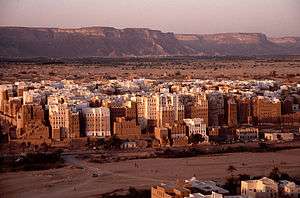
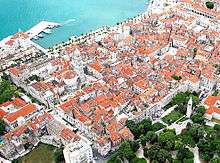

.jpg)
